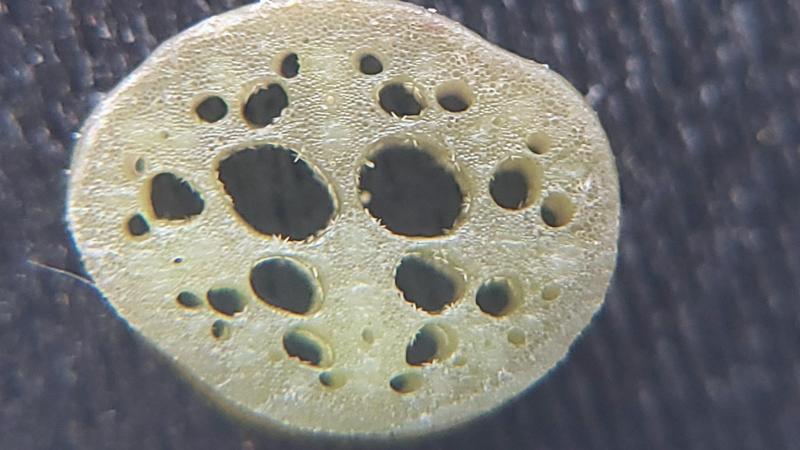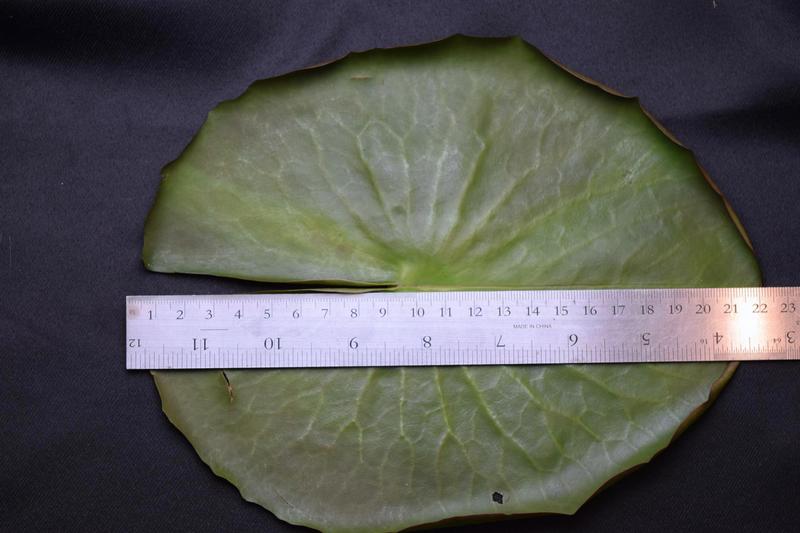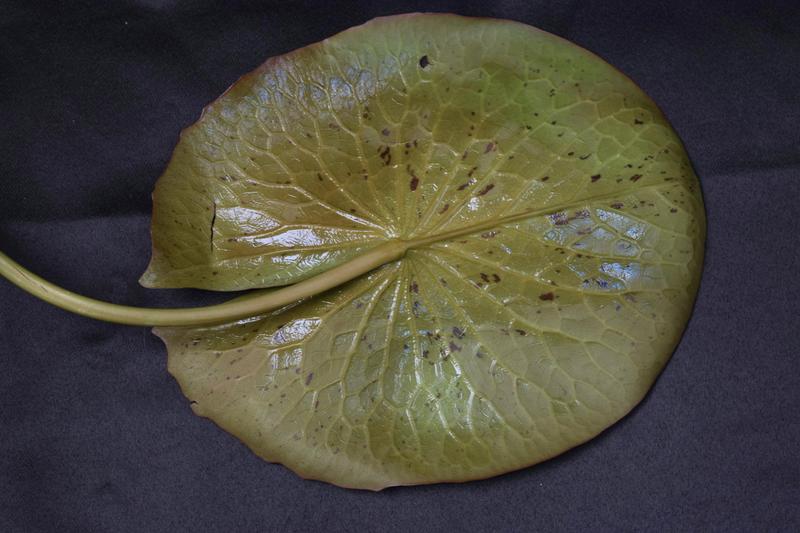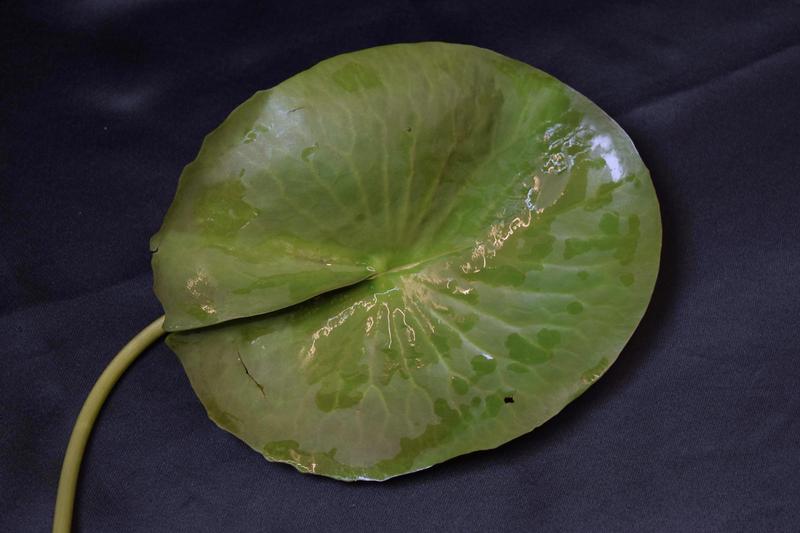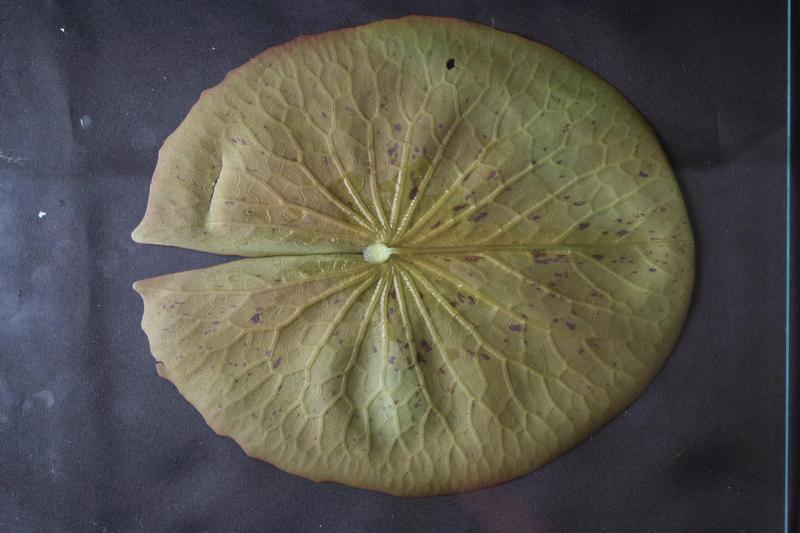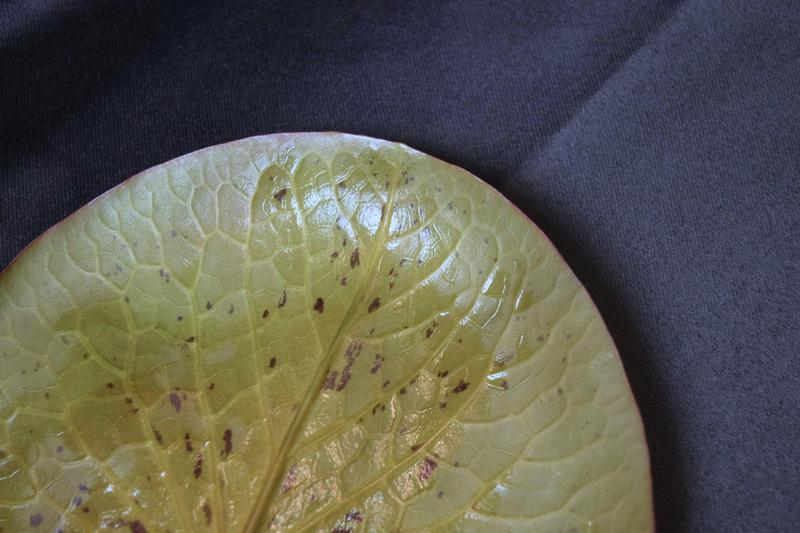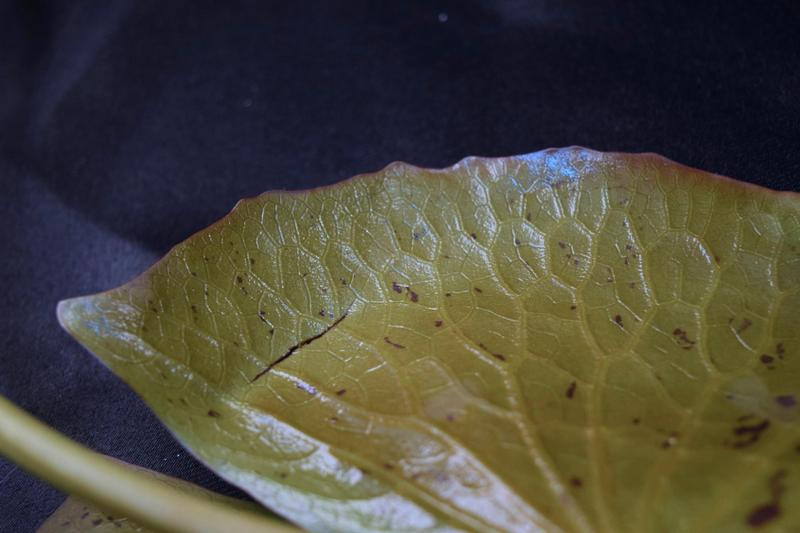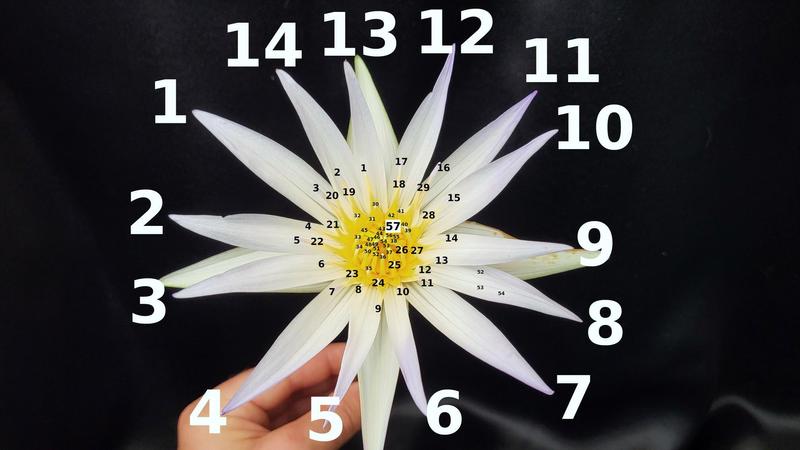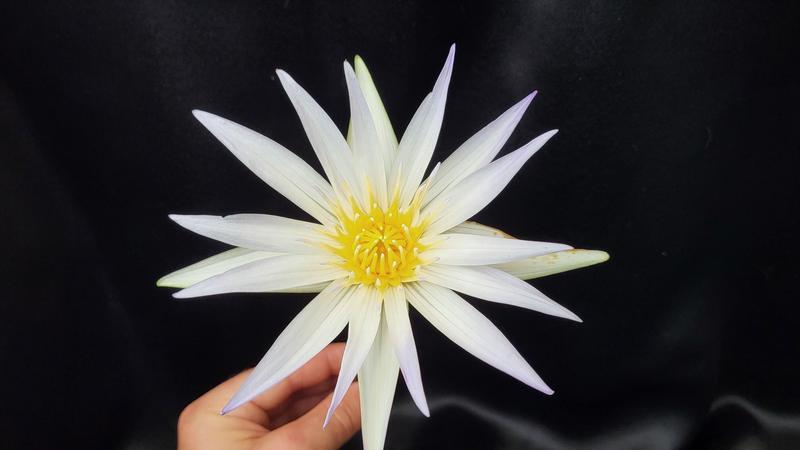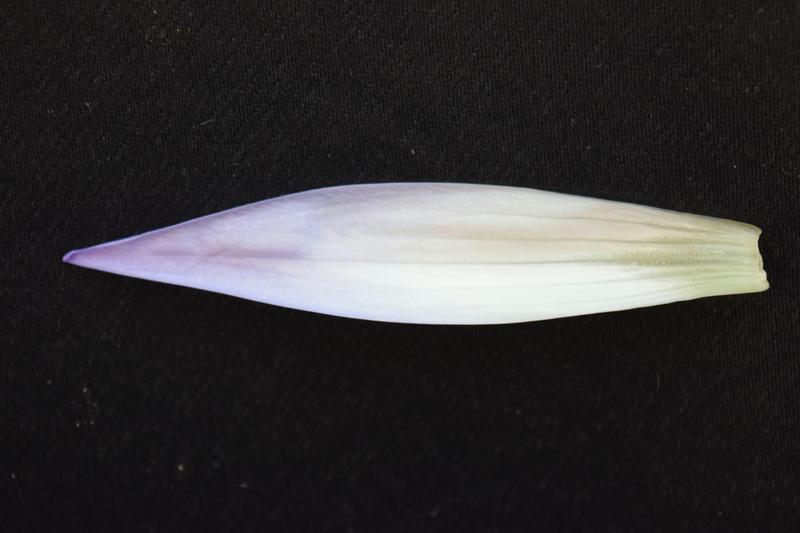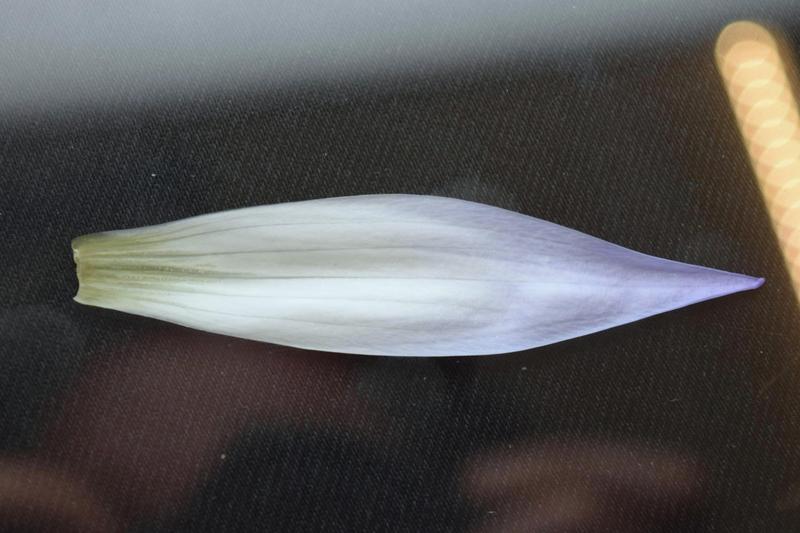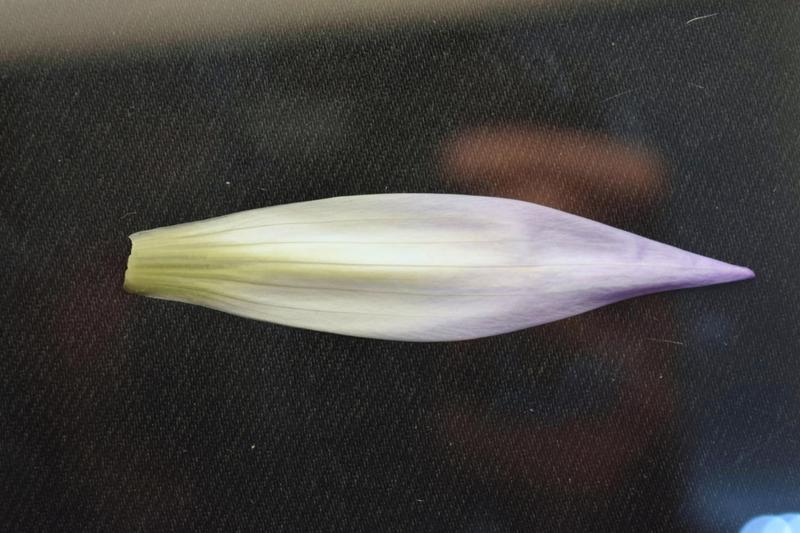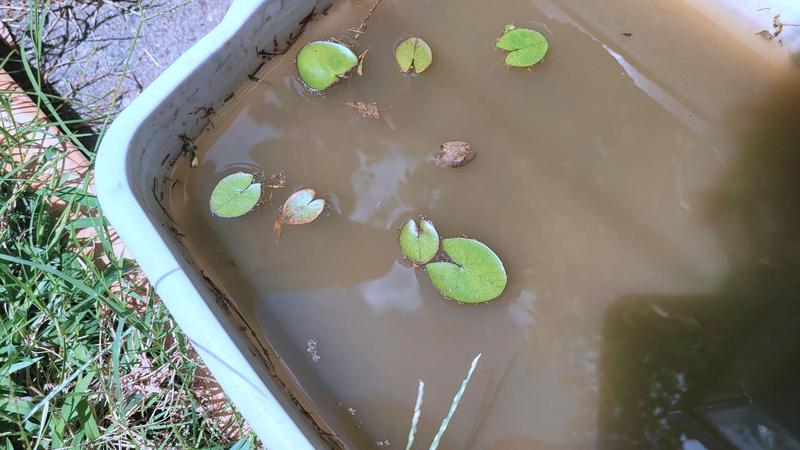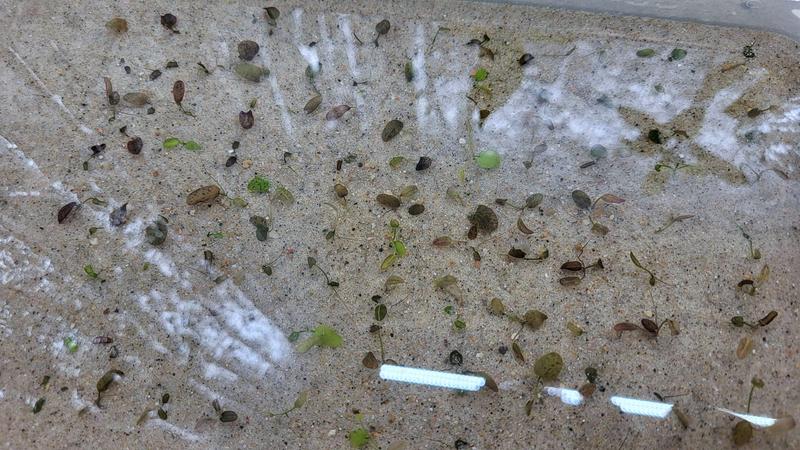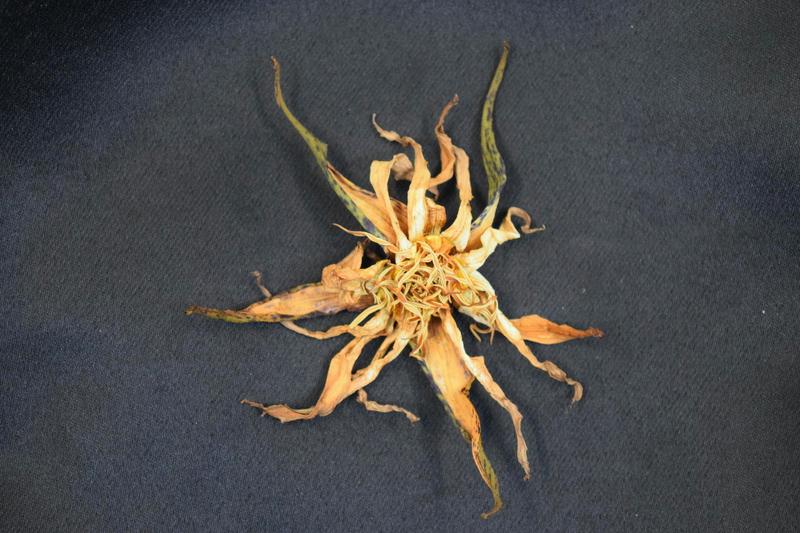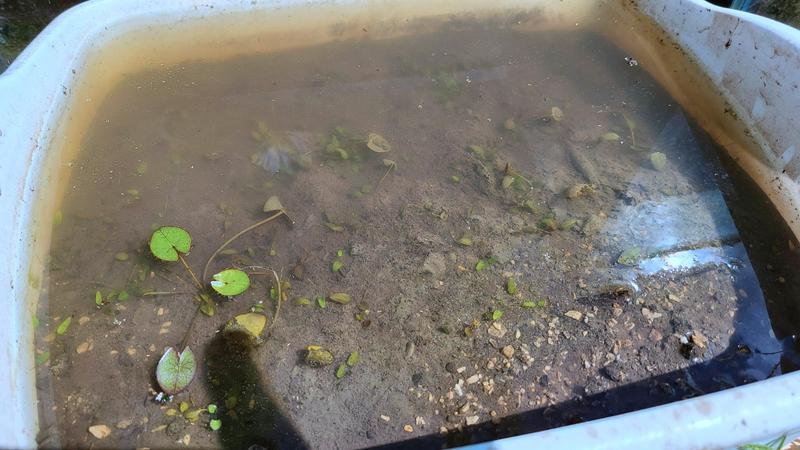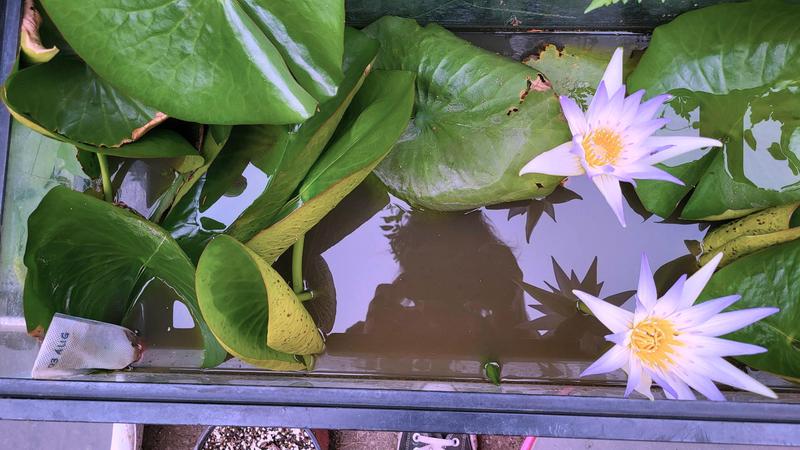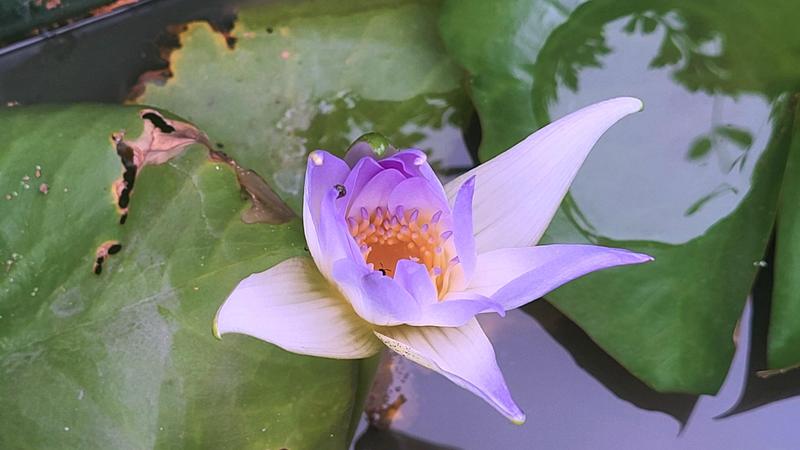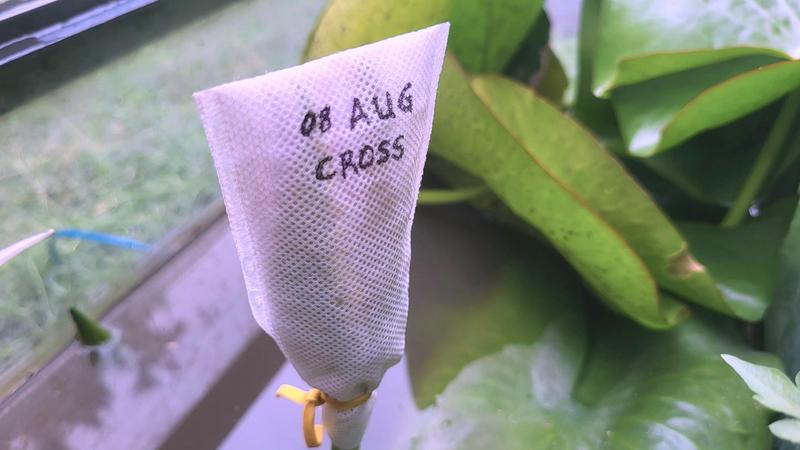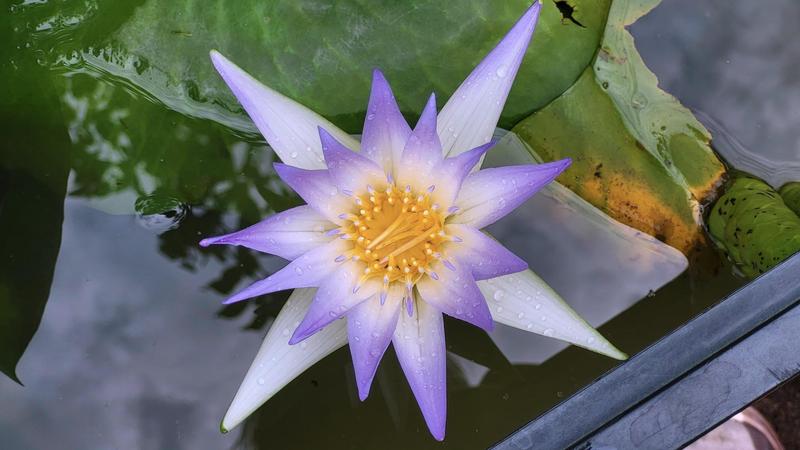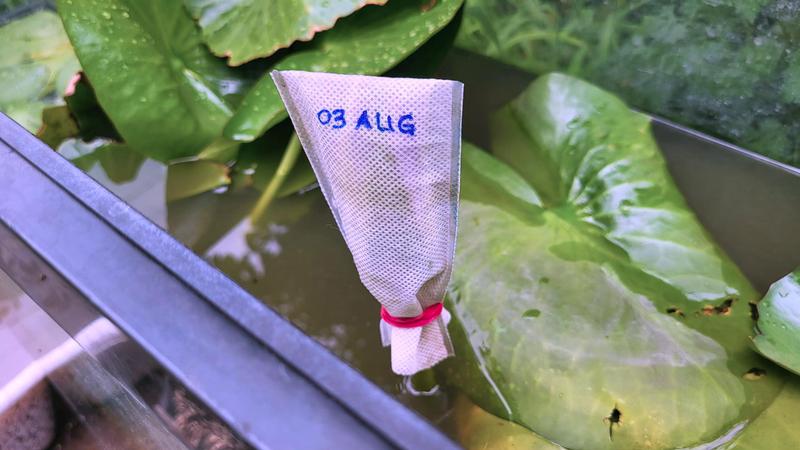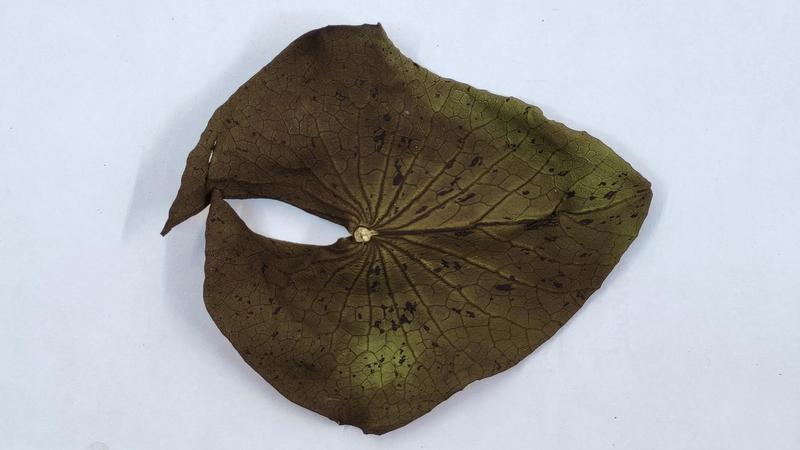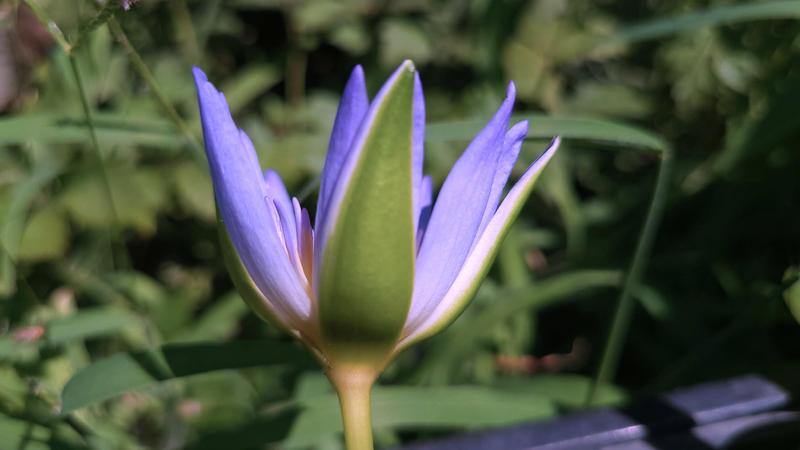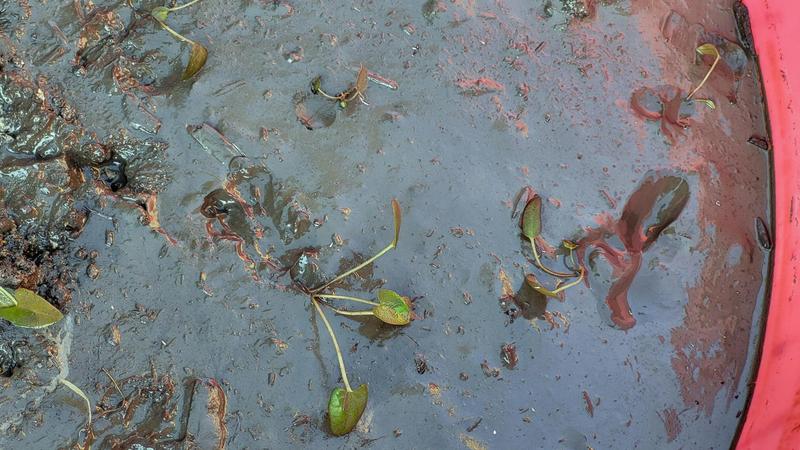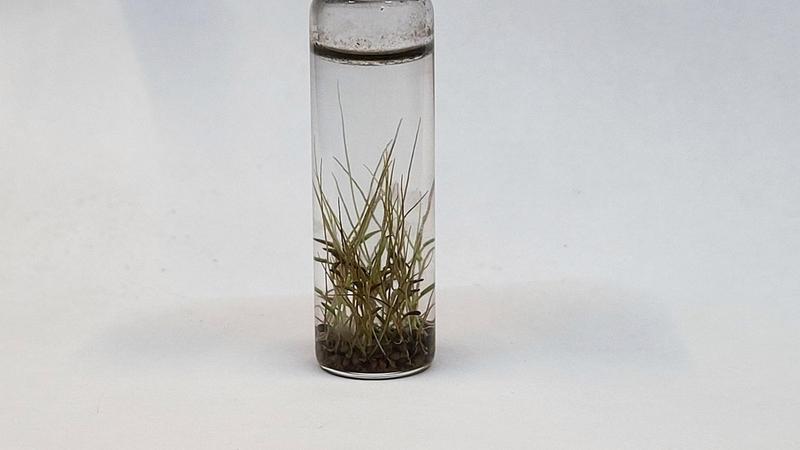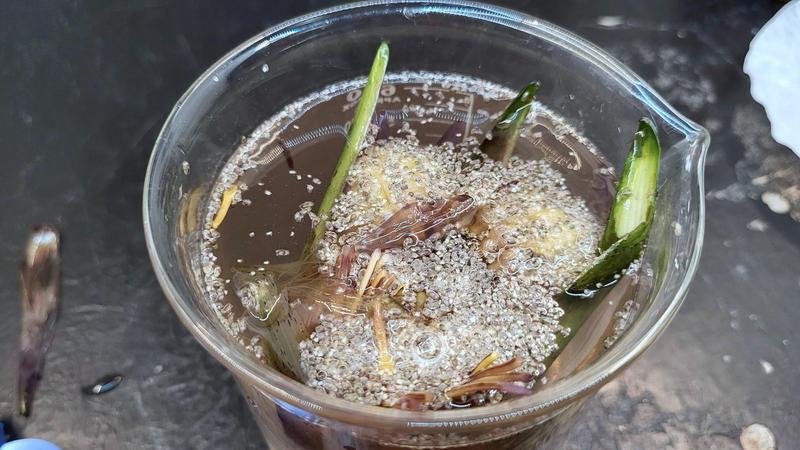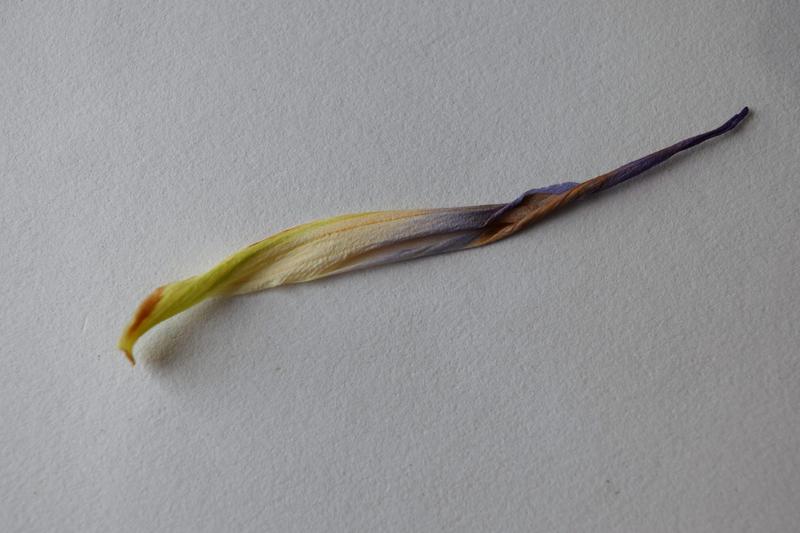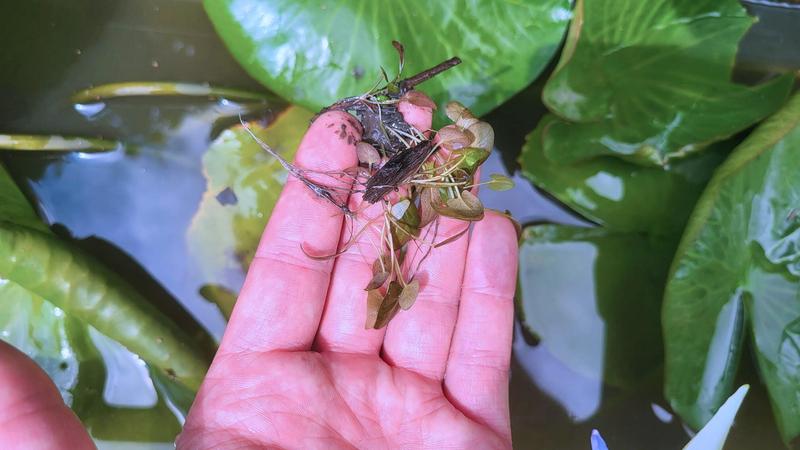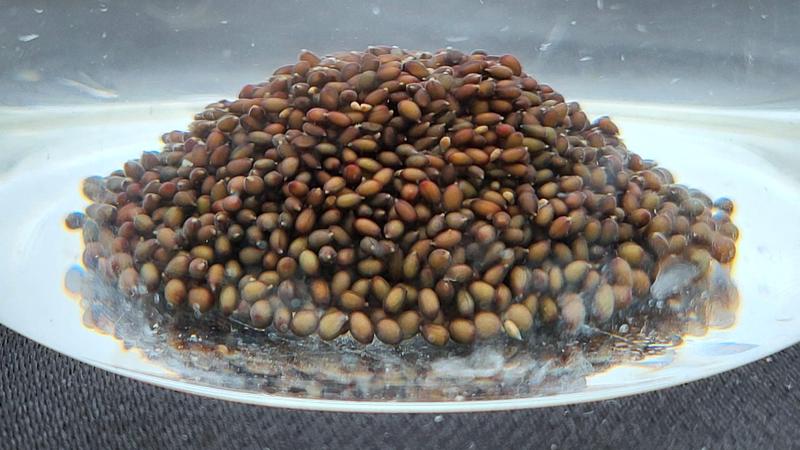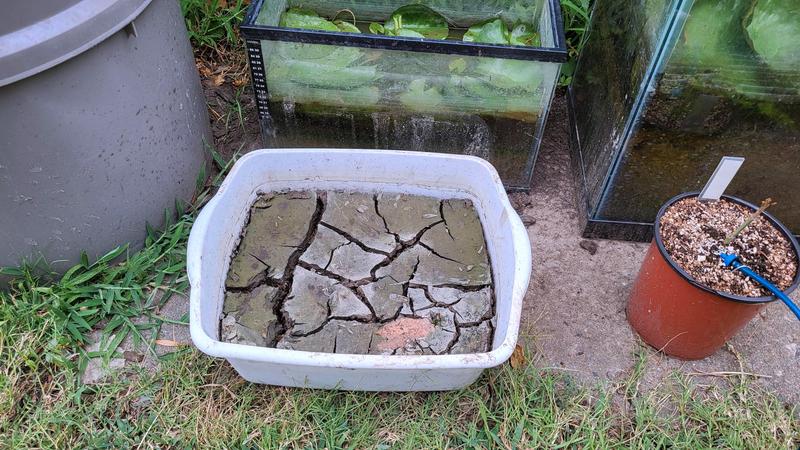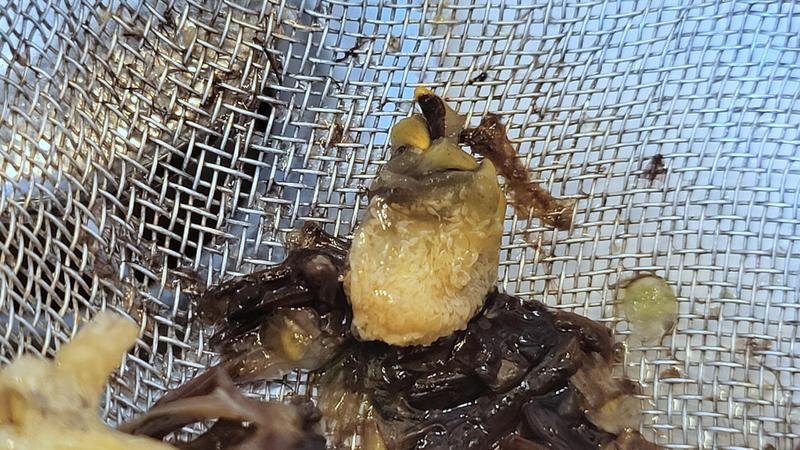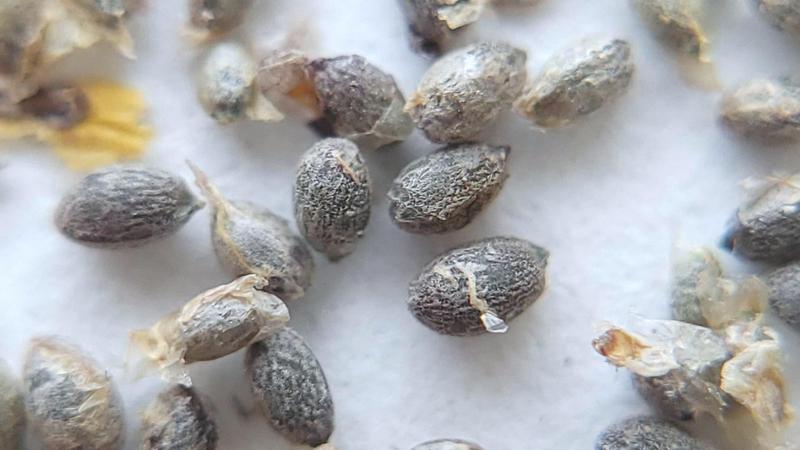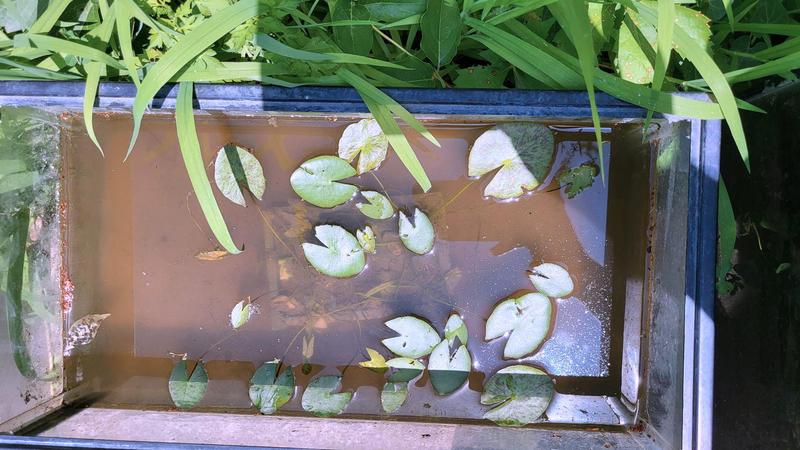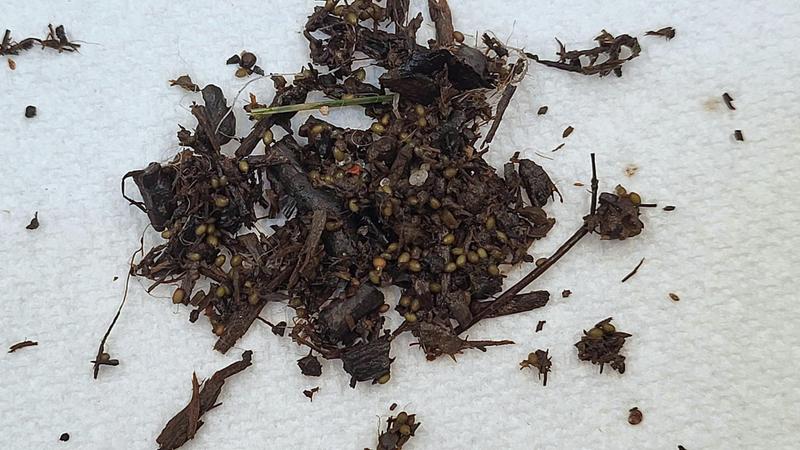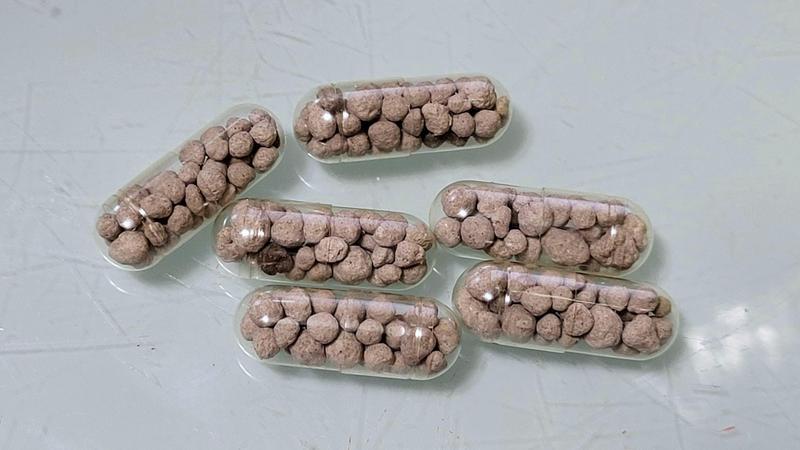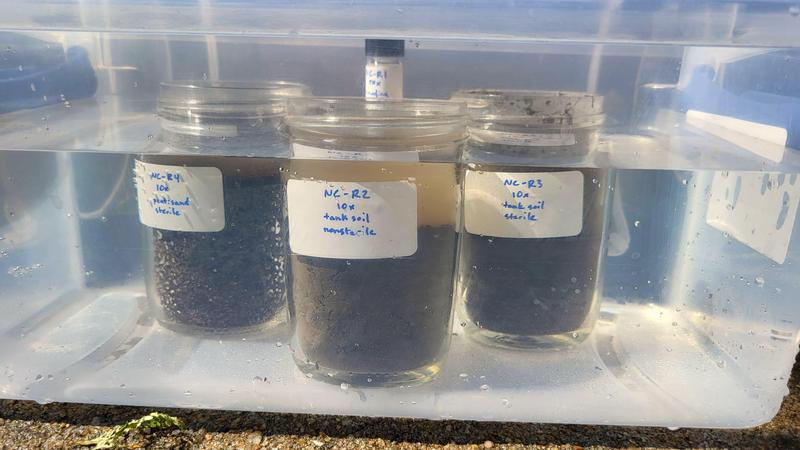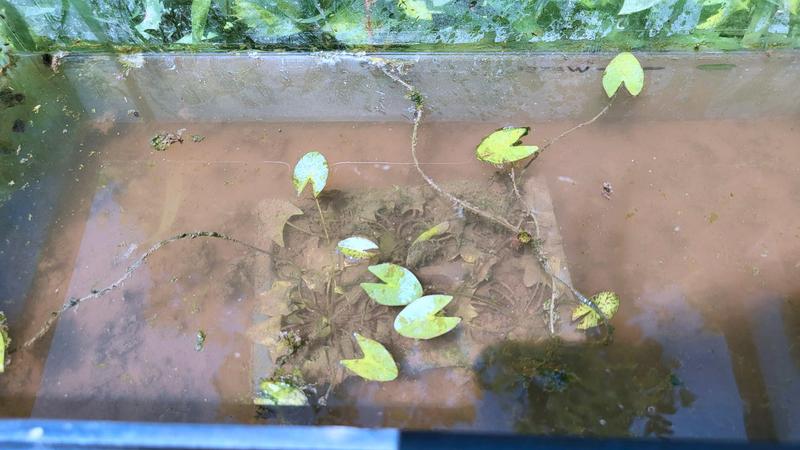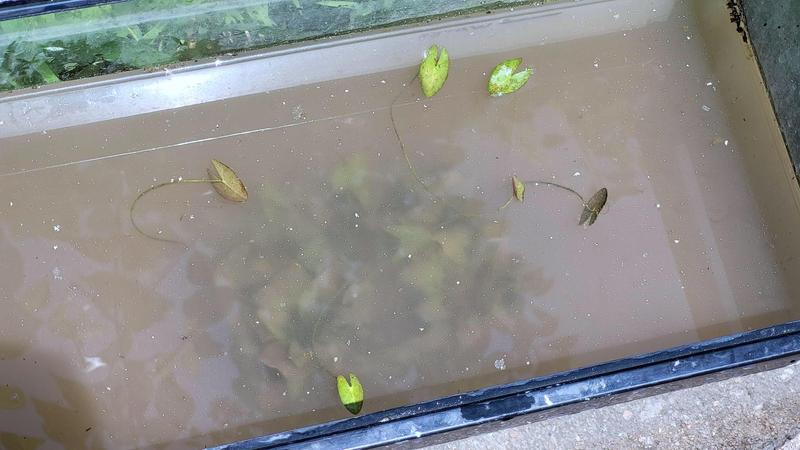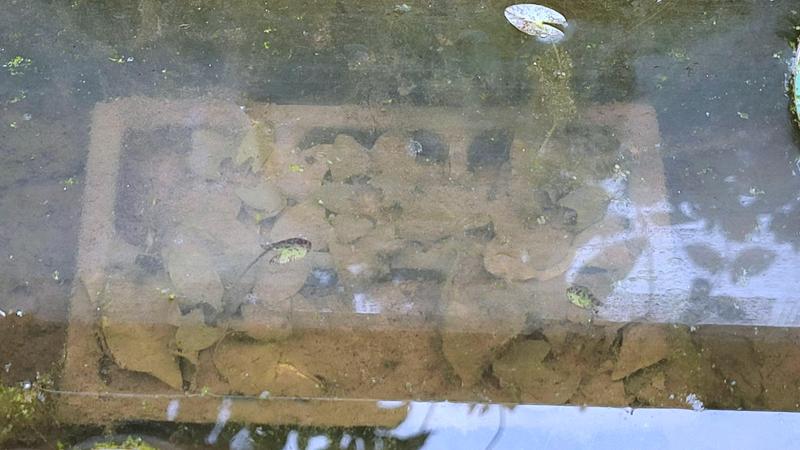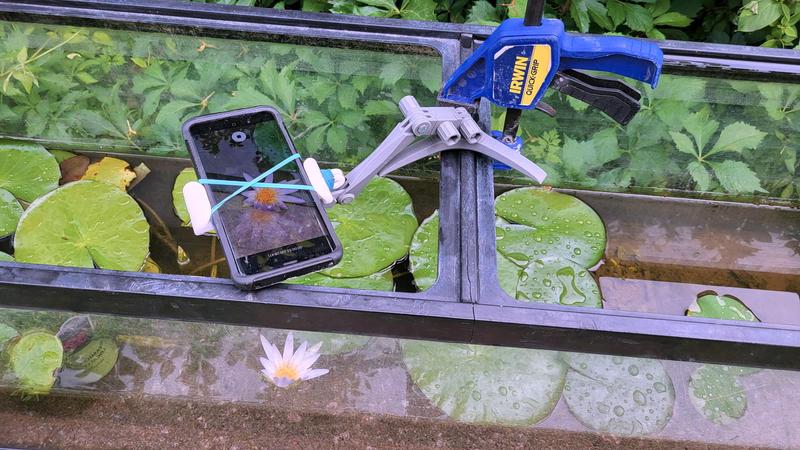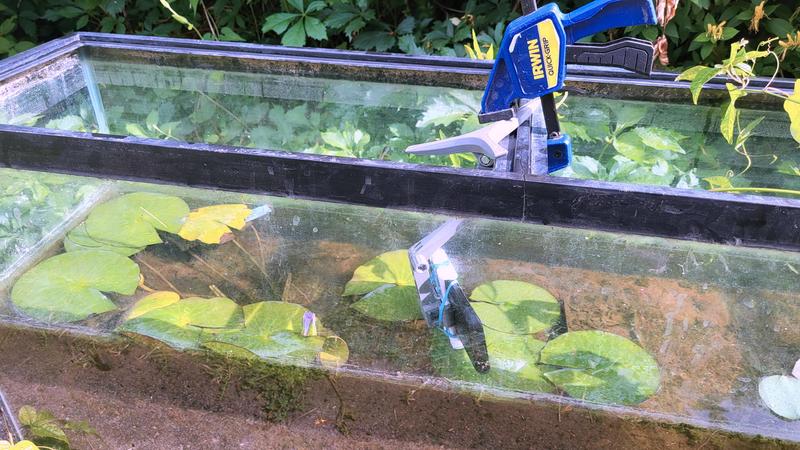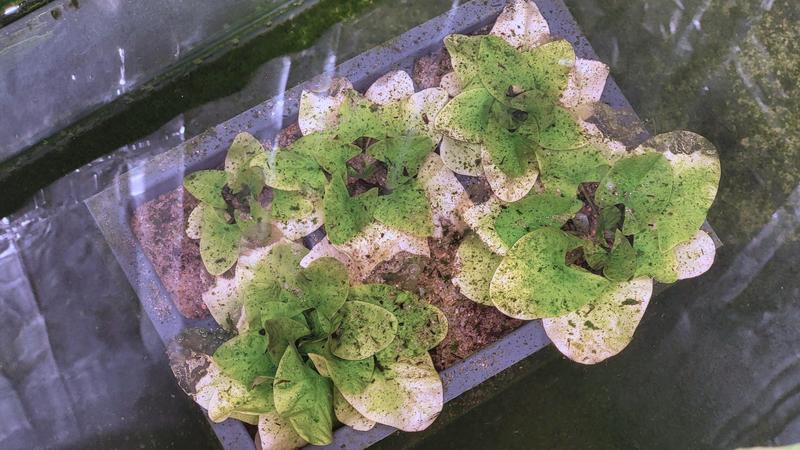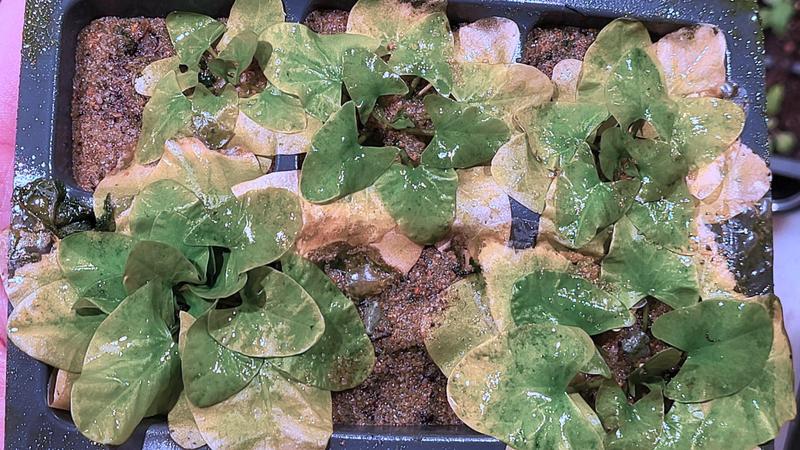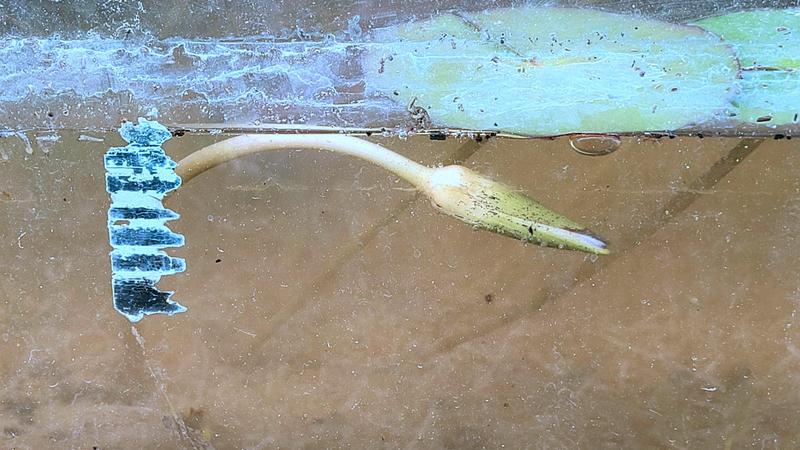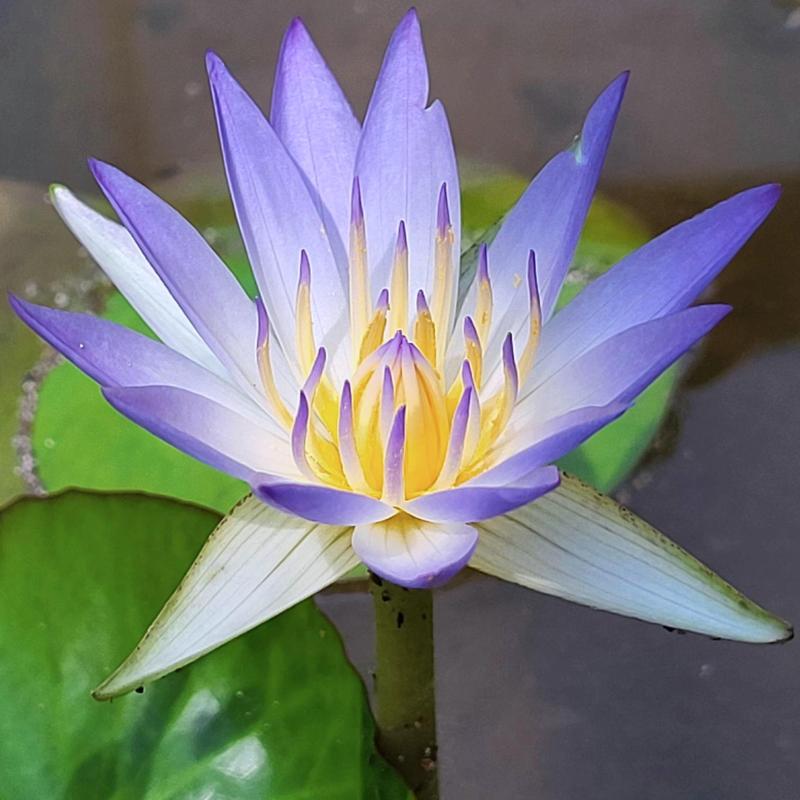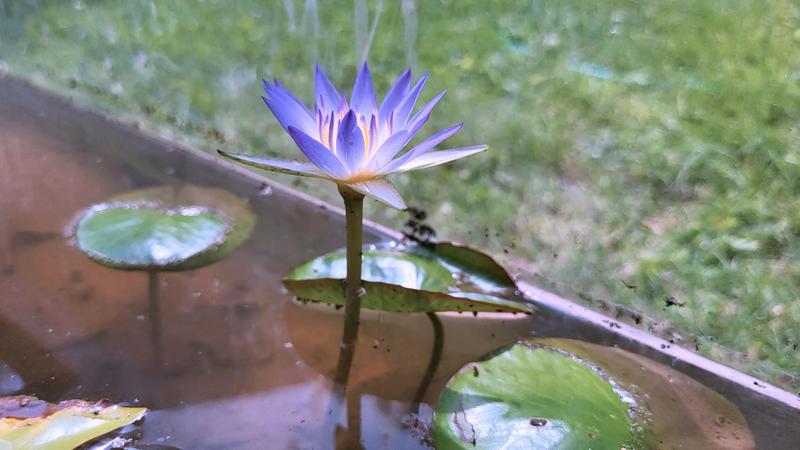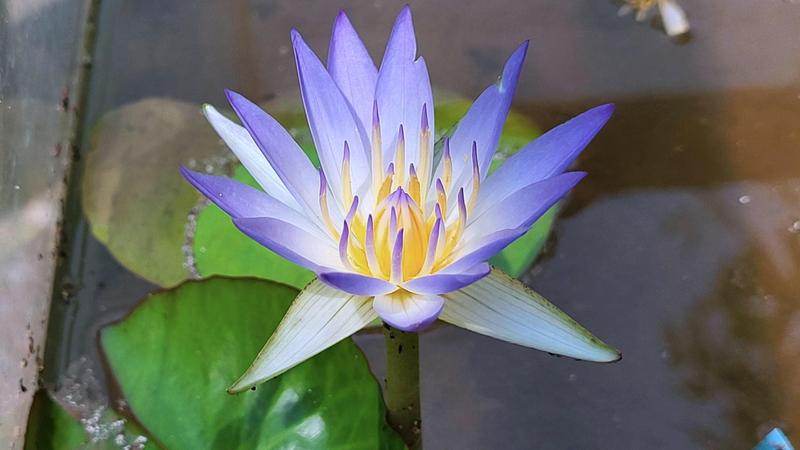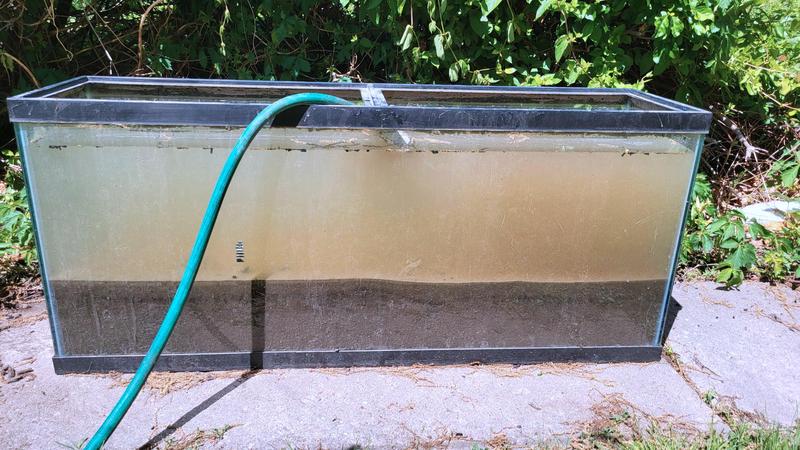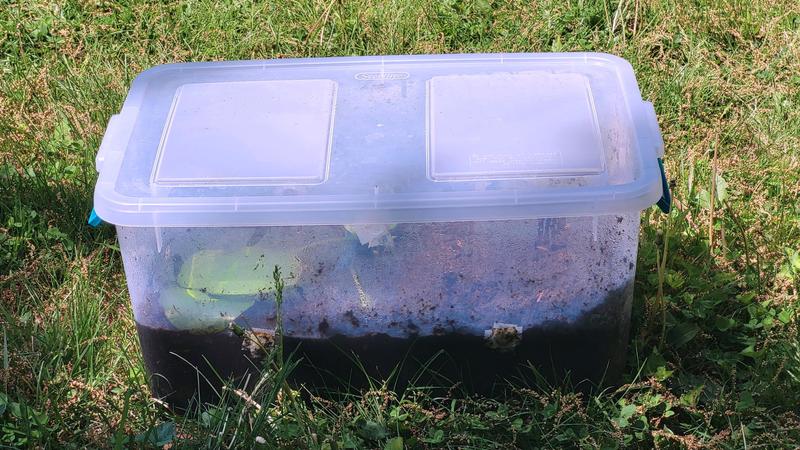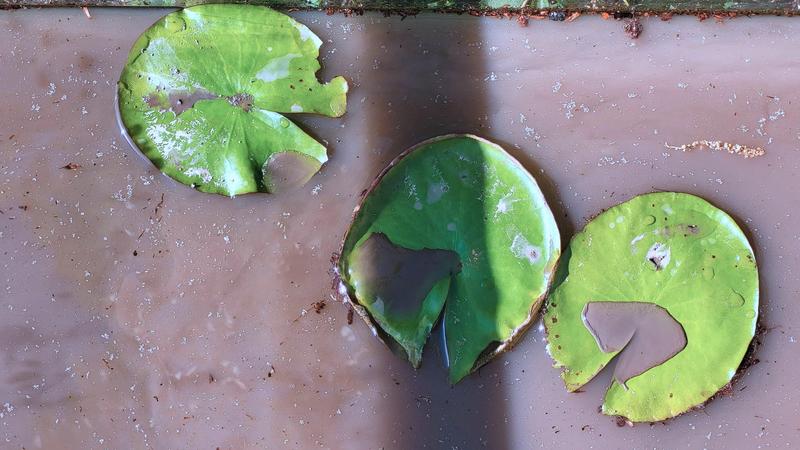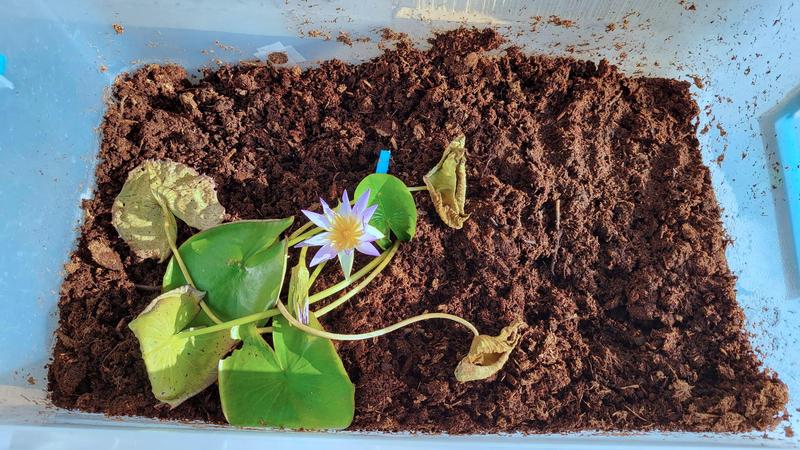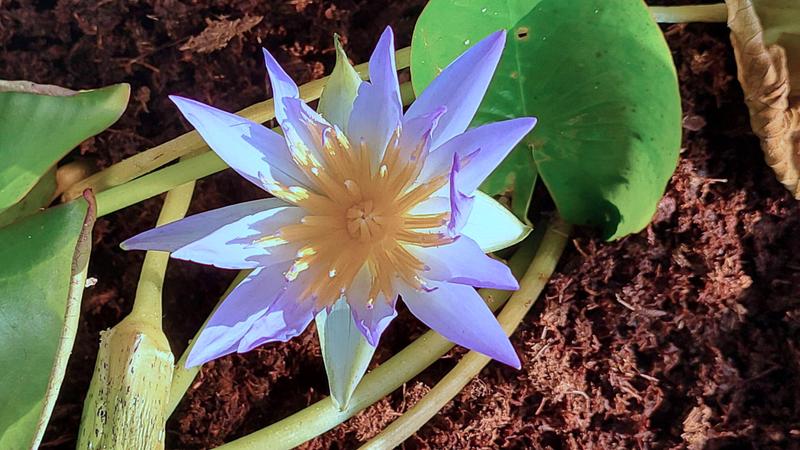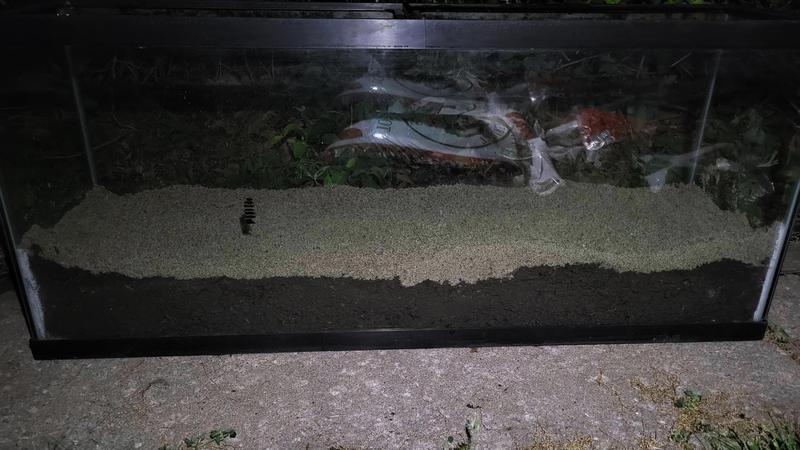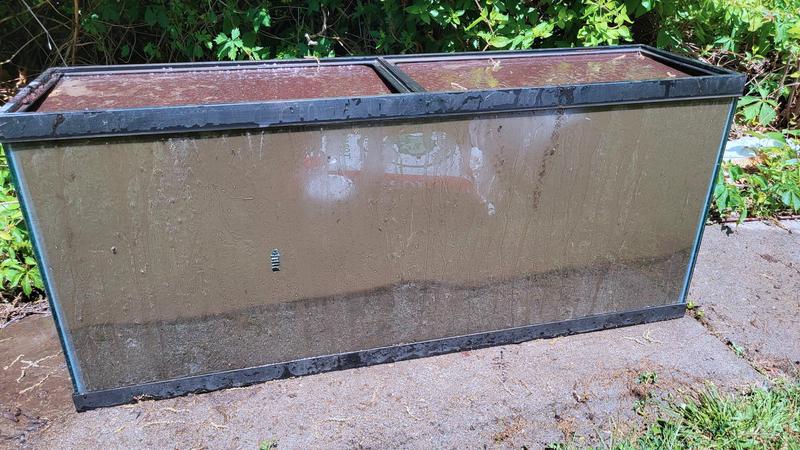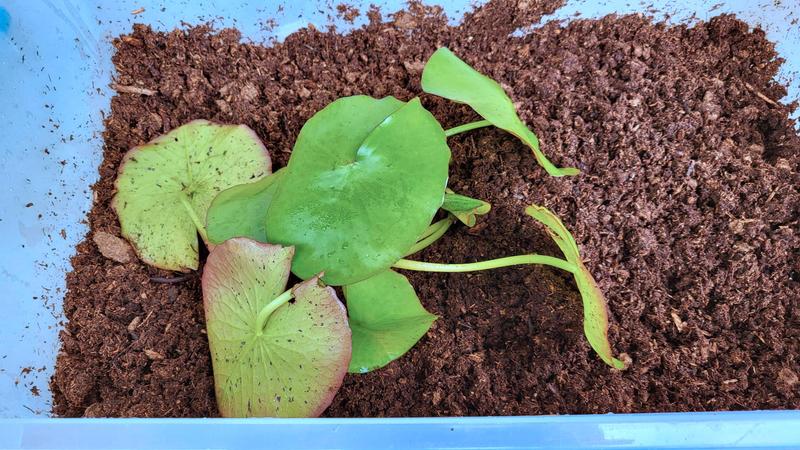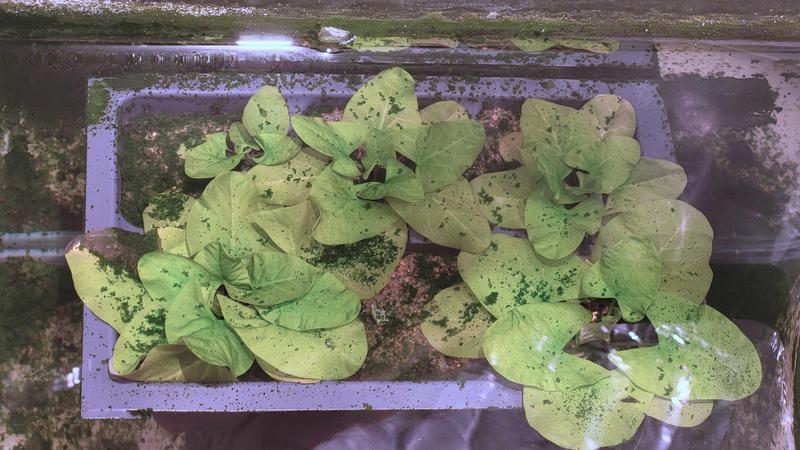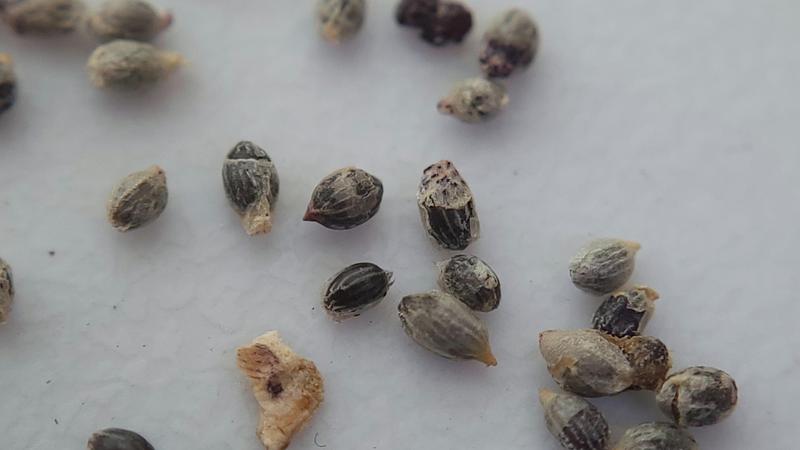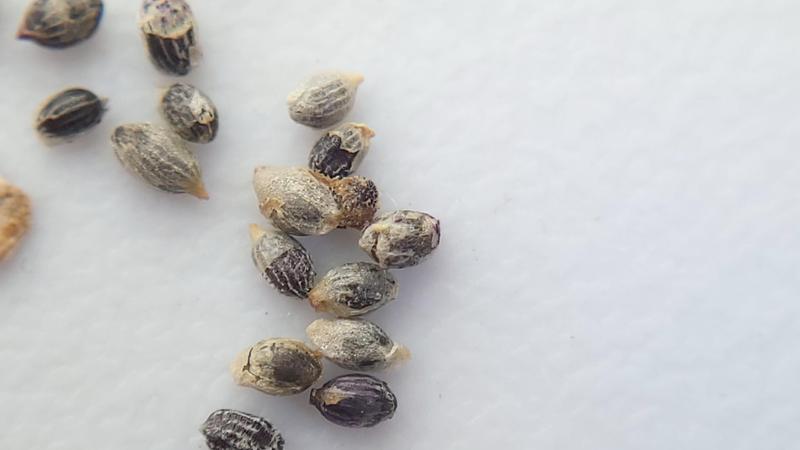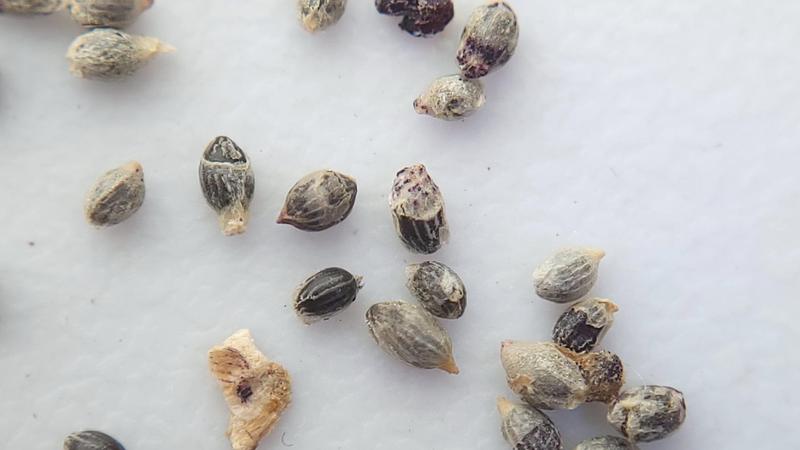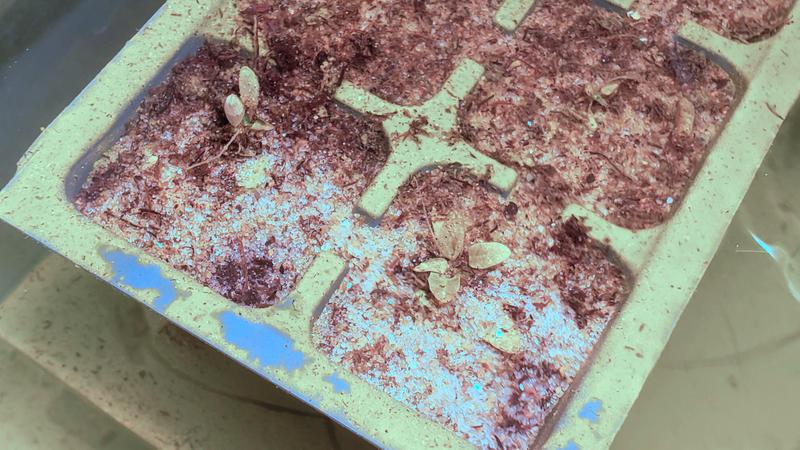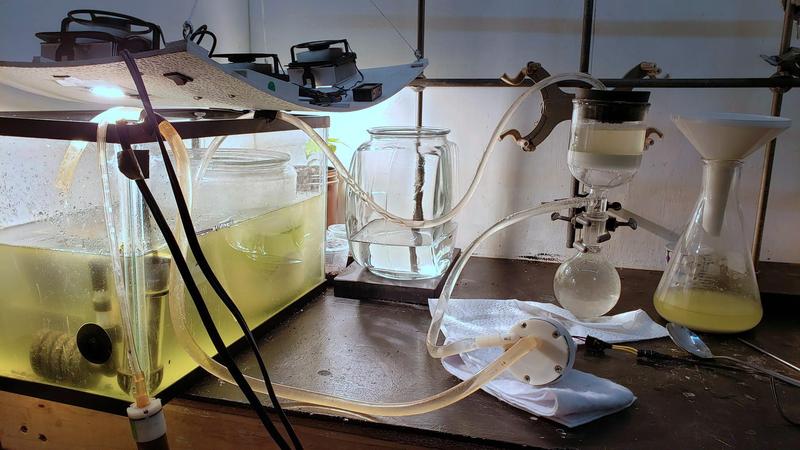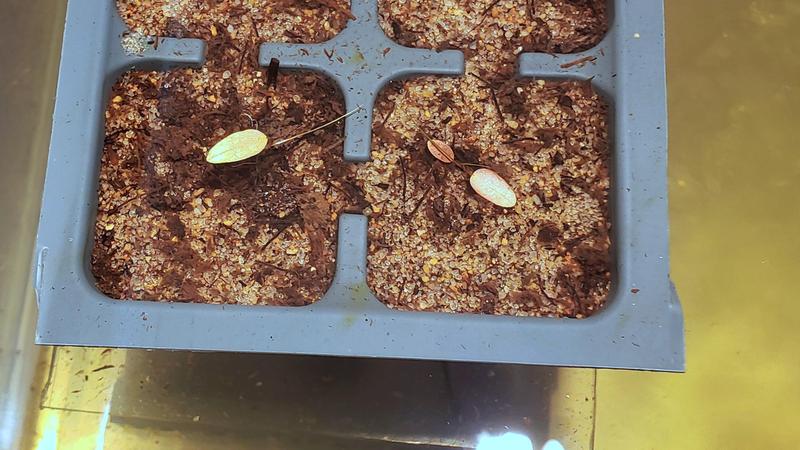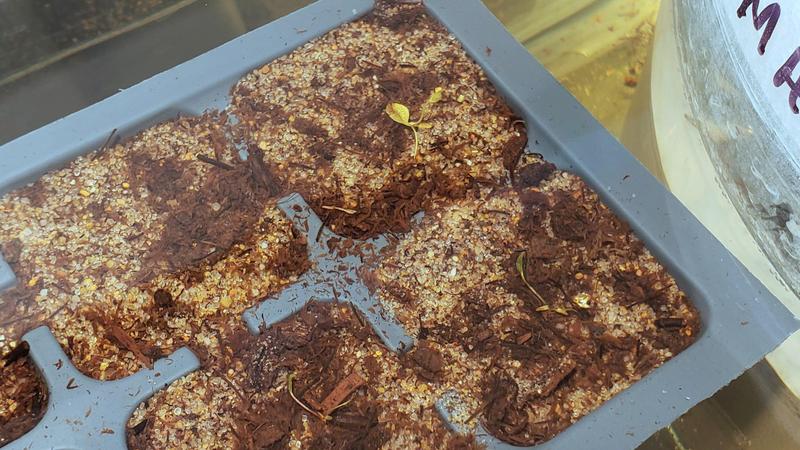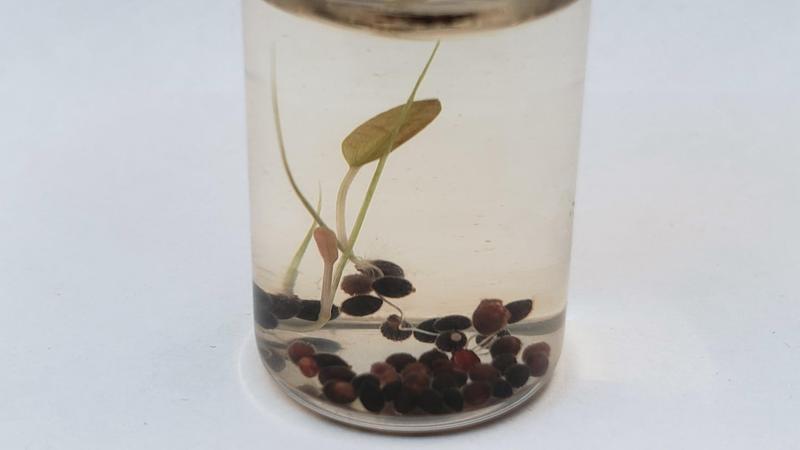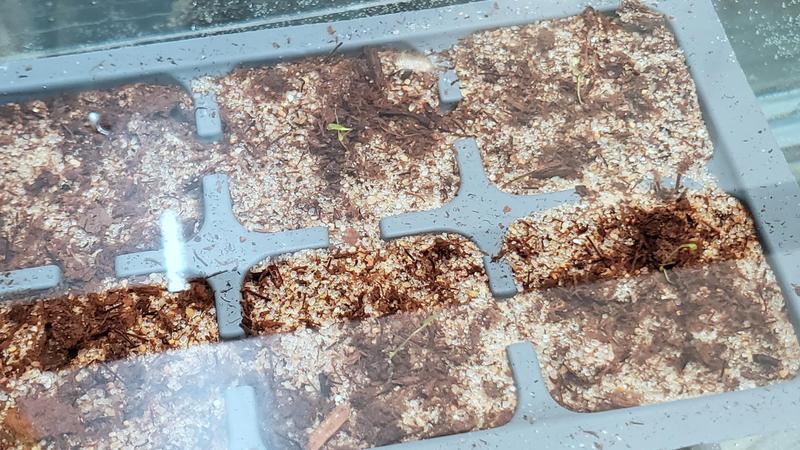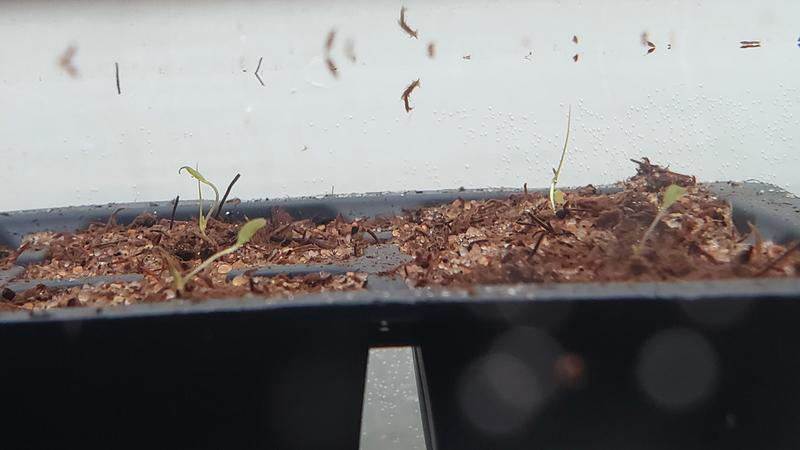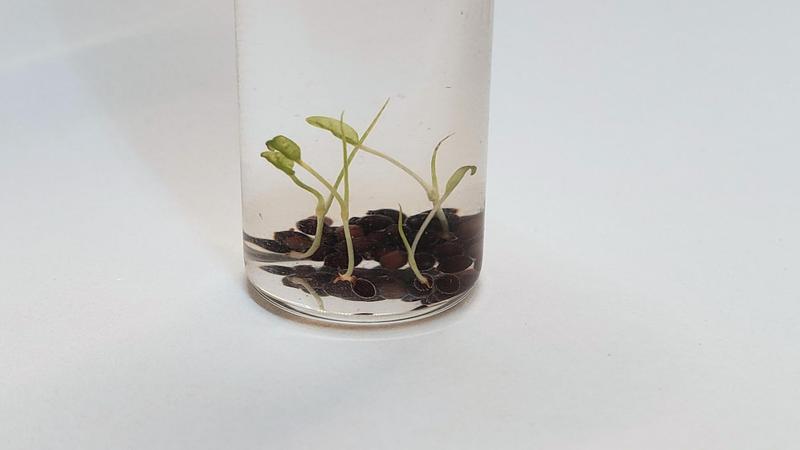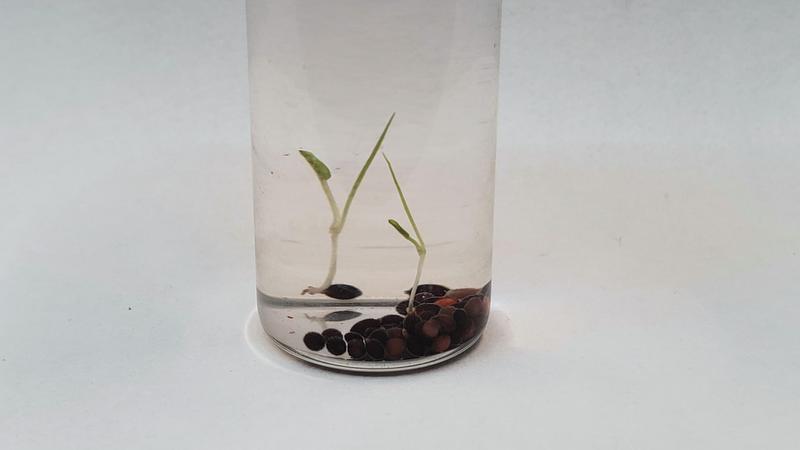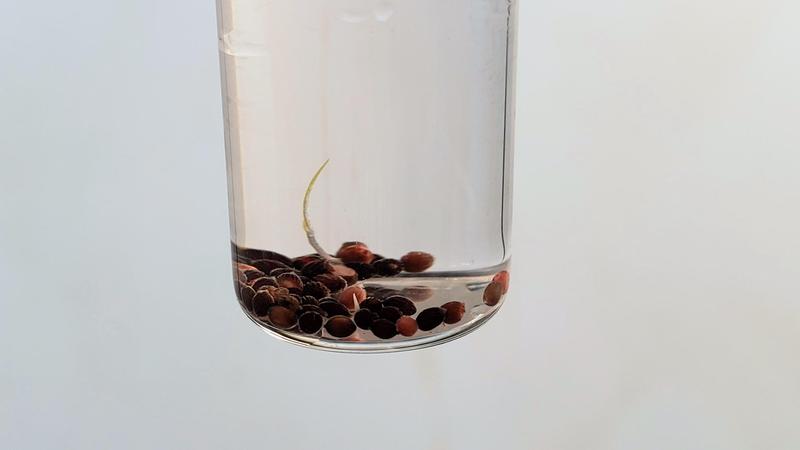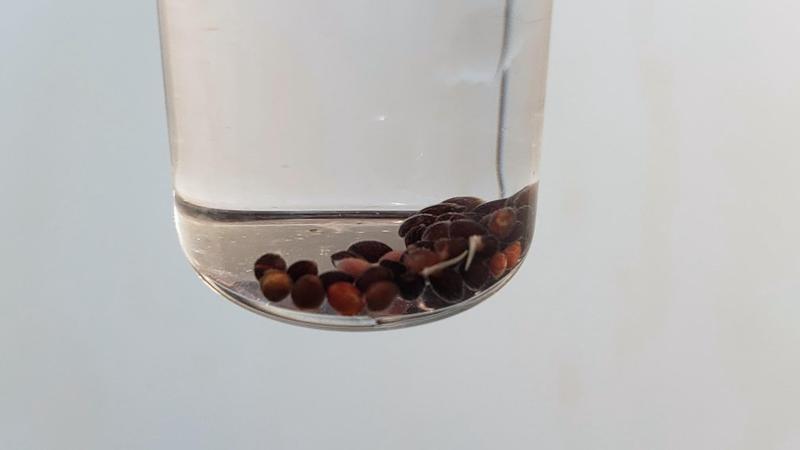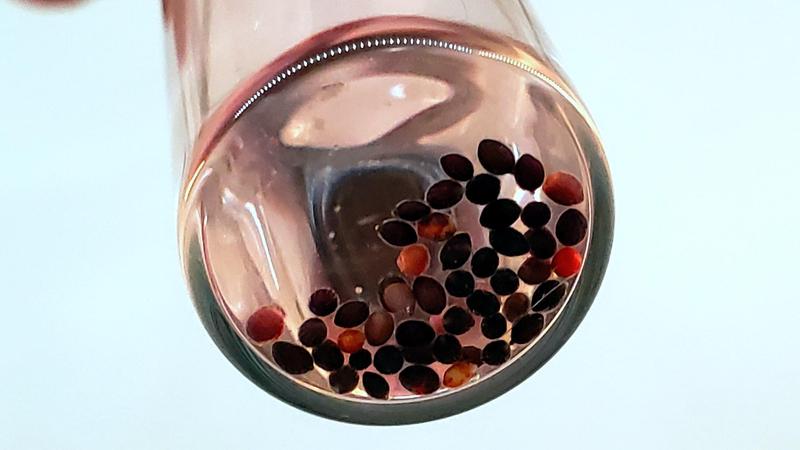Nymphaea caerulea
An ornamental and medicinal water lily most known from Ancient Egyptian depictions of its flower used in a ritualistic setting. N. caerulea is difficult to obtain due to the abundance of misidentified, dark blue Nymphaea spp..
Videos
Propagation
Caerulea can be propagated from spongy rhizomes or seeds.[1]
Caerulea can hybridize with micrantha.[2] This hybrid is actually outcompeting the pure caerulea.[3]
Autogamous, protogynous.[4]
The seeds of caerulea (and most? Nymphaea) are surrounded by mucilage and trapped air that allow the seeds to float after fruit dehiscence. The air slowly escapes allowing the seeds to sink after a day or so.[5][6][7]
Germination
| media | germination | temperature °C | note | reference |
|---|---|---|---|---|
N. odorata germination improves considerably when seeds are crowded together in small volumes of water (100 seeds in 20ml water). Similar germination rates are seen with incubation with ethylene-producer ethephon.[8]
Bacterial growth occurred in the seeds disinfected via standard method of using CloroxTM. Mature seeds scarified with 75 % H2SO4 for 60 seconds gave contamination free cultures with optimum seed germination.[3]
Seed color is indicative of seed maturity, transitioning from orange-red to dark brown with increasing age. Stage 5 seeds exhibited the greatest germination potential.[9]
stage 5: seed coat was dark brown, rows of longitudinal trichomes present and thick air-containing sack-like, pulpy aril covered.[9]
Light is necessary for germination in caerulea var. versicolor.[9] It is worth noting that Bodhipadma et al. used over 100 seeds per vessel. Crowding effects cannot be ruled out.
N. alba germination is largely independent of pH and alkalinity.[10]
Caerulea probably have physical dormancy as well.[3] Other species in the Nymphaea genus do not.[11]
Generally, incubation at 35°C is better than 30°C across several Nymphaea species. The same for crowding and illumination.[11]
Finely sieved clean loam soil without any organic matter or fertilizer is used. Seeds should be sown thinly, covered lightly with soil and then plunged into shallow water, no deeper than 2.5 cm, and placed in a sunny position. Germination should take three-to-four weeks.[12]
Caerulea seeds will not germinate further after a second drying event indicating that their seeds replenish every year.[13]
Vegetative
The only Nymphaea known to produce epiphyllous plantlets is micrantha. Lasiophylla and prolifera reproduce asexually via aborted flowers. The rest reproduce with stolons or rhizome enlargement. The ease and speed of propagation from plantlets have been used by plant breeders in dozens of hybrids. The plantlets grow opposite to the petiole when the leaf is detached.[4][14]
In-Vitro
| basal media | supplements | source | target | note | reference |
|---|---|---|---|---|---|
Caerulea seeds have trichomes making surface sterilization difficult. Other species like alba and lotus do not have trichomes.[3]
Seed disinfection with 70% ethanol for 1 minute, 10% Clorox bleach for 10 minutes, and 75% sulfuric acid for 1 minute followed by germination on MS media supplemented with 0.5 mg/L 2,4-D and 2 mg/L BAP had a germination rate of 66%.[3]
Attempts to induce somatic embryogenesis have failed.[3]
Cultivation
| Planting density (m-2) | inter-row space (cm) | intra-row space (cm) | note | reference |
|---|---|---|---|---|
Three-month-old seedlings are 5-15 cm in total length depending on the depth of planting.[15]
Nymphaea adapt to the container size.[16]
Harvest
Caerulea grown from seed can take up to four years to develop flowers.[12]
Yield
| product | source | yield per season (kg/ha) | note | reference |
|---|---|---|---|---|
| product | source | yield per plant | note | reference |
|---|---|---|---|---|
Soilless
Sand:sphagnum peat moss 2:1 (v/v) growing medium has been used for the cultivation of N. rosea and N. sunrise in pots.[16]
Aurora has been hydroponically cultivated in gravel.[17]
Soil
| soil type | pH | C-content % | precipitation | temperature (°C) | altitude (m) | note | reference |
|---|---|---|---|---|---|---|---|
Fertilization
| type | rate | time | note | reference |
|---|---|---|---|---|
| double phosphate (0-17.6-0) | 2-6 g/plant | basal + 2/4/6 weeks | fertilization | [18] |
| urea (46-0-0) | 0.5-1.9 g/plant | basal + 2/4/6 weeks | fertilization | [18] |
| ammonium sulfate (21-0-0) | 1.4-4.2 g/plant | basal + 2/4/6 weeks | fertilization | [18] |
| commercial fertilizer | 20 g/plant | basal + 2/4/6 weeks | fertilization | [18] |
| calcium sulfate dihydrate | 0-6.0 g/plant | basal | fertilization | [18] |
| 93 potassium sulfate/7 potassium carbonate | 0-6.0 g/plant | basal + 2/4/6 weeks | fertilization | [18] |
| 55 lime/ 45 dolomite | 20 g/plant | basal | fertilization | [18] |
| Calcium nitrate, magnesium sulfate | 2 g/L; 0.5g/m2 | 1/wk foliar spray | fertilization | [18] |
| copper oxychloride, zinc sulfate | 1 g/L; 0.24 g/m2 | 1/month foliar spray | fertilization | [18] |
| Solubor (sodium borate) | 1 g/L; 0.24 g/m2 | every ~6-weeks foliar spray | fertilization | [18] |
| trace fertilizer: 10 Fe/5 Zn/5 Cu/5 Mn/2 B/0.05 Mo | 2.0 g/plant | basal | fertilization | [18] |
N. tetragona can be grown in 1/4 strength Hoagland hydroponic nutrients.[19]
Very few studies of Nymphaea fertilization have been conducted. In a study of phosphorus and potassium nutrition of flowering Nymphaea ‘Cowara Purple’, the fertilizer doses tested were 1.85-5.89 N, 0.28-2.53 P, 0.79-9.17 K, 1.43-6.24 S, 0.91-2.50 Ca, 0.18-0.43 Mg in grams per plant (5 kg soil in 4.5 L pots).1 The fertilizers were added in multiple doses as sachets buried in the growing media and by foliar spray. The best combination in terms of all measured performance measures, were 2.0-0.8-1 or 3.4-2.5-0.8 N-P-K g/plant.[18]
Phosphorus supply seems to be the main limiting factor in waterlily growth, though this might depend on the soil P-sorbing capacity. Staines et al. suggest water lilies would likely have responsed positively to higher doses than the maximum used in the study (2.53 g/plant).[18]
Flower number and size decreased with increasing potassium application rates from 0.79-9.17 g/plant in N ‘Cowara Purple.[18]
N. nouchali var. cernua has been noted to indulge in a primitive form of insectivory. Other N. nouchali and N. rubra growing in the same pond did not exhibit this behavior.[20]
Temperature
Lighting
| fixture type | photoperiod | illumination | note | reference |
|---|---|---|---|---|
N. nouchali are impressive photosynthesizers, especially for C3 plants.[21] Optimal irradiance is approximately 1000 umol m-2 s-1 PAR but they can maintain exceptionally high photosynthesis rates in full sunlight (~2100 umol m-2 s-1).[21]
Maximal gross photosynthesis achievable by N. nouchali is on the order of 5.3 g C m-2 d-1.[21]
Pests
Storage
Caerulea is a tropical waterlily that does not survive cold temperatures. One popular preservation method is cold storage.
Ken Landon recommends a method of long-term storage using plastic bags and fabric at room temperature.[22][23]
Materials
- Nymphaea tuber
- small, resealable plastic bag
- square of synthetic polyester felt at least 4× the size of the tuber
- harvest plant as it goes dormant (cold temperatures, lack of fertilizer, dryness, pot bound)
- rinse off in nonchlorinated water
- cut roots and leaves off (do not pull!)
- dip felt square in clean water
- squeeze excess moisture out of felt
- wrap tuber in felt
- pack in plastic bag
- seal tightly
- label bag with date, species, variety, etc.
- store at room temperature (light level doesn’t matter)
- check on tuber at least once per year
- a) remoisten fabric
- b) ensure growing tips are still alive
- c) ensure no fungal growth
- tuber can be kept for years or maybe decades in this manner
A useful video: Prepare to make tubers with a annual/tropical waterlily.
An alternative method of storage suitable for a single overwintering:
- harvest plants at the end of the season while still actively growing
- cut off all roots and remove all but 2-3 of the newest leaves
- place rhizome horizontally on soil bed without fertilizer
- secure with wire if necessary
- periodically remove any decaying material
- when ready to grow again in a few months, cut off bottom portion where roots are not actively growing
- repot and grow as usual
Ecology
Twenty distinct endophytic fungi have been isolated from plants parts of nouchali. Several species from the genera fusarium, colletotrichum, endomelanconiopsis, and curvularia were found, and a single species from each of trichoderma, chaetomium, phomopsis, berkleasmium, alternaria, setosphaeria, phyllosticta, and neofuscicoccum. Crude extracts from these fungi have antimicrobial properties.[24]
Morphology
| character | measurement | unit | notes | reference |
|---|---|---|---|---|
Nymphaea is a diverse genus, so research may not be transferable between species. Perhaps the closest species to nouchali is rubra.[25]
The taxonomy is confused, to say the least.[26][27][25][28]
There are about 50 species of Nymphaea.[27]
Nymphaea readily hybridize.[29] Wild collected specimens of alba have anywhere from 28 to 84 chromosomes. These hybrids outcompete the parents and are virtually indistinguishable except by genetic/cytological studies.[30]
Three different morphologically-identified nouchali have 2n=56, 2n=70, and 2n=84 chromosomes (4,5,6 ploidy, respectively). Caerulea (listed separately) is 2n=28.[31][12][32]
Nymphaea stellata is 2n-28.[32]
Karyotype analysis on N. stellata showed 2n = 28. [22] Another study on the chromosome number of N. nouchali was seen to be euploidy in nature. Three types have been identified, N. nouchali (Type 1) 2n = 56, N. nouchali (Type 2) 2n = 84, and N. nouchali (Type 3) 2n= 70. N. nouchali (Type 1) 2n = 56 (4x) chromosomes may have evolved by the doubling of a chromosome (2n = 28) from the ancestral species. Similarly, N. nouchali (Type 2) 2n = 84 (6x) may have evolved from the chromosome doubling of N. daubeniana 2n = 42 (3x). N. nouchali (Type 3) 2n = 70 (5x) might have originated by the crossing of N. pubescens 2n = 84 (6x) and N. nouchali (Type 1) 2n = 56 (4x).[12]
Most often, caerulea is listed as having 2n=28 chromosomes, but occasionally 14 or 56. CCDB
Floating-leaved, anchored, tuberous/rhizomatous perennial.[33]
Caerulea readily hybridizes with micrantha and capensis.[34]
All blue water lilies were, at one point, treated as a single species: Stellata (Hooker and Thompson) despite contemporary evidence of disparate morphology.[5]
Hybrids and cultivars have been available commercially for over 170 years (circa 1851).[5]
Caerulea and capensis are listed as synonyms despite obviously differing morphology in the included images.[1]
Roots
Stem
A transverse slice of the petiole showing the air canals.
Leaves
Entire margins for most of the leaf.
Randomly crenate margins nearest the wedge.
Dried petiole and leaf.
Inflorescence
Hermaphroditic, diurnal protogynous flowers.[7]
Flowers open in the morning and close in the afternoon.[1]
Drying a caerulea flower in the sun.
I picked a flower for you.
Sepals
A closer view of the sepal veins.
A closer view of the sepal specs.
Petals
Seeds
SEM images of the seeds of alba and candida do not reveal trichomes.[35]
Upwards of 90% of the seed volume is occupied by perisperm.[5]
Names
- Nymphaea caerulea Savigny
- Nymphaea nouchali Burm.
- Nymphaea nouchali var. caerulea
- Nymphaea nouchali var. nouchali[36]
- Nymphaea stellata Willd.[37]
- Nymphaea stellata car. cyanea (Roxb. ex G. Don) Hook.f.[38]
- Nymphaea stellata var parviflora Hook.f. & Thomson[38]
- Nymphaea caerulea subsp. zanzibarensis[37]
- Nymphaea minima Bailey[37]
- Nymphaea capensis Thunb.[37]
- Castalia caerulea Tratt.[38]
- Castalia scutifolia Salisb.[38]
- Castalia stellaris Salisb.[38]
- Castalia stellata (Willd.) Blume[38]
- Nymphaea bernierana Planch.[38]
- Nymphaea cyanea Roxb. ex G. Don[38]
- Nymphaea emirenensis Planch.[38]
- Nymphaea madagascariensis DC.[38]
Erroneous Names
- Nymphaea pubescens Willd.
Phytochemistry
| compound | source | concentration (mg/g dry weight) | note | reference |
|---|---|---|---|---|
[39] [40] [41] [42] [43] [44] [45] [46]
The blue flowers of caerulea possess flavonols with the rhamnosyl moiety in the aglycone 3-position and anthocyanins with galactosyl moieties in the 3-position.[41]
Infraspecific Variation
Biosynthesis
Distribution
Alkaloids are present only in the leaves and flowers of caerulea. Flavonoids are highest in the flowers (23 ug Quercetin Equivalent/g) followed by leaves (12 ug QE/g). Phenols are relatively evenly distributed in the leaves (325 mg Tannic Acid Equivalent/g), flowers (315 mg TAE/g), rhizomes (210 mg TAE/g), and roots (1801 sic mg TAE/g).^[1] [45]
Timecourse
Improvement
| trait | improvement status | reference |
|---|---|---|
Identification
| variety | description | reference |
|---|---|---|
Inheritance
Methods
| type | note | reference |
|---|---|---|
History & Society
A funeral wreath from the tomb of Ramses II was identified as N. caerulea.[48]
Most of the waterlily plants depicted in Ancient Egyptian art have entire leaves and acute petals with distinct blue coloring. Leaves and petals of caerulea were made into wreaths and placed in coffins. Sometimes, however, petals of N. lotus were found in the tombs. Since the leaves of lotus are distinctly dentate and the petals are more obtuse, it is unlikely that the two were confused in art.[5]
Work Log
09 Dec 2024
| group | germination | deformed |
|---|---|---|
| 1a | 0% | 0% |
| 1d | 0% | 0% |
| 2d | 0% | 0% |
| 3a | 100% | 0% |
| 3d | 100% | 0% |
| 4d | 100% | 0% |
| 5a | 87% | 0% |
| 5d | 100% | 0% |
| 6d | 100% | 0% |
| 1e RS Open 03 AUG-28AUG | 40% | 27% |
| NC #2 10 JUL | 100% | 0% |
I never opened 1a, 1d, and 2d because it was obvious the lack of germination. They were placed back in the germination chamber just in case.
So that’s good evidence that storage at either 4°C (fridge) or -18°C (freezer) maintains near perfect germination for 1+ year. Desiccation pretreatment had no effect.
19 Nov 2024
I’m a bit late on the germination tests.
Somehow I mixed up the labels on the vials. I am putting 1a, 1d, 2d, 3a, 3d, 4d, 5a, 5d, and 6d into germination right now. Oops. I guess it doesn’t matter too much since the results won’t be affected. I’m also going to start what I’m calling group 1e. These were seeds stored in a glass vial that was repeatedly opened and closed throughout the year as I sold seeds.
02 Apr 2024
| group | germination | deformed |
|---|---|---|
| 1c | 100% | 47% |
| 2c | 100% | 0% |
| 3c | 100% | 0% |
| 4c | 100% | 0% |
| 5c | 100% | 0% |
| 6c | 100% | 0% |
Well… so much for storage viability differences. The only result so far is a number of small/deformed seedlings in the 1c group. These seedlings were half or quarter the size of the others with crooked leaves. This is the first instance of deformation.
07 Mar 2024
Preliminary results: The seeds kept at 4°C and -18°C have started to germinate already. The seeds kept at room temperature have not. I think storage in the refrigerator is the best moving forward.
29 Feb 2024
Started groups 1c, 2c, 3c, 4c, 5c, and 6c (a few days late).
28 Nov 2023
| group | germination |
|---|---|
| 1b | 100% |
| 2b | 100% |
| 3b | 100% |
| 4b | 100% |
| 5b | 100% |
| 6b | 100% |
Ya know… it’s hard to determine the cause of a loss of viability if the seeds never lose viability!
31 Oct 2023
Now that RS caerulea is safely located in the dungeon, fertilization can resume. Implanted two capsules of osmocoat and one of TSP.
30 Oct 2023
| group | germination |
|---|---|
| 2a | 100% |
| 4a | 100% |
| 6a | 100% |
Of the accessions started on 21 Aug:
| accession | germination |
|---|---|
| RS self 14 Jul | 20% |
| RS open 12 Aug | 60% |
| RS open 01 Aug | 80% |
| RS open 03 Aug | 87% |
02 Oct 2023
Started the 1-month germination trial groups 1b, 2b, 3b, 4b, 5b, and 6b.
28 Aug 2023
Pollinated and bagged a second flower from RS plant using dried stamens from Epony plant. This time there wasn’t any pollen on the flower already, so it should be a true cross.
The 2022 seeds have lost viability in under one year of storage at RT in a sealed vial. I need to find a better storage protocol. The most likely condition is cold storage. Based on previous, short-duration trials, N. caerulea is amenable to both 4°C (fridge) and -18°C (freezer) storage. There is also the intervening factor of moisture content. So the question is: How does storage in the fridge/freezer compare to RT and how is it affected by desiccation.
All pods from the 2023 season have high initial germination. The 03Aug flower produced the most seeds, so I will focus testing on that one. 24 groups of 15 seeds each.
- storage duration
- storage temperature
- desiccation
| accession | group # | pretreatment | storage | temperature | count | note |
|---|---|---|---|---|---|---|
| 03Aug | 1a | none | 0 | RT | 15 | |
| 03Aug | 1b | none | 1 month | RT | 15 | |
| 03Aug | 1c | none | 6 months | RT | 15 | |
| 03Aug | 1d | none | 12 months | RT | 15 | |
| 03Aug | 2a | CaCl2 desiccation | 0 | RT | 15 | |
| 03Aug | 2b | CaCl2 desiccation | 1 month | RT | 15 | |
| 03Aug | 2c | CaCl2 desiccation | 6 months | RT | 15 | |
| 03Aug | 2d | CaCl2 desiccation | 12 months | RT | 15 | |
| 03Aug | 3a | none | 0 | 4°C | 15 | |
| 03Aug | 3b | none | 1 month | 4°C | 15 | |
| 03Aug | 3c | none | 6 months | 4°C | 15 | |
| 03Aug | 3d | none | 12 months | 4°C | 15 | |
| 03Aug | 4a | CaCl2 desiccation | 0 | 4°C | 15 | |
| 03Aug | 4b | CaCl2 desiccation | 1 month | 4°C | 15 | |
| 03Aug | 4c | CaCl2 desiccation | 6 months | 4°C | 15 | |
| 03Aug | 4d | CaCl2 desiccation | 12 months | 4°C | 15 | |
| 03Aug | 5a | none | 0 | -18°C | 15 | |
| 03Aug | 5b | none | 1 month | -18°C | 15 | |
| 03Aug | 5c | none | 6 months | -18°C | 15 | |
| 03Aug | 5d | none | 12 months | -18°C | 15 | |
| 03Aug | 6a | CaCl2 desiccation | 0 | -18°C | 15 | |
| 03Aug | 6b | CaCl2 desiccation | 1 month | -18°C | 15 | |
| 03Aug | 6c | CaCl2 desiccation | 6 months | -18°C | 15 | |
| 03Aug | 6d | CaCl2 desiccation | 12 months | -18°C | 15 | |
| 03Aug | total | 360 |
The remainder of the seeds will be stored in the refrigerator. They can be used for longer term studies.
- groups 2,4,6 -> desiccator for 1 week
- group 1 -> RT storage
- group 3 -> frigerator storage
- group 5 -> freezer storage
Storage times: 28 days, 182 days, 365 days
06 Aug 2023
Made some osmocoat capsules and ice cubes. Main plant continues to develop flowers and seeds.
Since high potassium seems to reduce Nymphaea growth, we should limit the dose by that measure. 0.8-1.0 g/plant should be the target for the growing season. Osmocote plus is 15-9-12. So for 1 g/plant K, that should be about 8.3 g osmocoat which would also deliver 1.25 g N, 0.75 g P, 0.11 g Mg, 0.5 g S, 1.7 mg B, 4.2 mg Cu, 38 mg Fe, 5 mg Mn, 1.7mg Mo, and 4.2 mg Zn. (P2O5 and K2O basis)
However, this results in a low dose of phosphorus, but that can be added separately as doses of triple super phosphate. Total dose should be >2.5 g/plant which leaves 1.75 g to be made up or 3.9 g/plant of TSP (0-45-0). The calcium of TSP will also be helpful since osmocoat has none.
Osmocoat Plus advertises a 6-month dissolution time. It is unclear how well the slow-release coating of osmocoat will perform underwater since that is not its intended environment. So we should probably split the dose application to an arbitrary two week interval. There’s only about 8 weeks left of the growing season, so four applications.
| fertilizer | dose | rate |
|---|---|---|
| osmocoat plus | 2.1 g | every two weeks |
| TSP | 1.0 g | every two weeks |
I will actually apply 1.25 g TSP because that’s how much fits into a ‘00’ capsule and because higher phosphate is a good thing. Similarly, I will apply 1.74 g osmocoat because that’s the weight of two ‘00’ capsules.
15 Jul 2023
Moving main rhizome to larger tank. 100L filled with tap water. I am worried about chloramine, so let’s neutralize it.
My municipal water source has 3.5 ppm chloramine. My tank is approximately 100L ( an excess). Therefore, the tank contains less than about 350mg of monochloramine or 6.8 mmol. A molar equivalent of sodium metabisulfite would be about 1.3 grams. Potassium metabisulfite might have been better or even ascorbic acid. Though at this dose, it won’t cause any real problems.
I added 1.3 grams to my tank. I’ll let it sit for a day or two, then add the water lily.
For a seedling tank, I ordered a cheap UV water sterilizer. Hopefully the combination of UV and filtering will eliminate my algae problem for seedlings.
25 May 2023
1:1 cast:peat cup has three sprouts, two of which have true leaves. The 100% peat cup has one thread leaf sprouting and smells like bad rotting compost. None of the other 11 May group have any sprouts nor do they have any smell.
13 May 2023
Sifted commercial peat moss through a 1mm wire mesh sieve to get “peat fines.” Yield about 50% of the volume uncompressed.
Did some experimentation with various mixes of peat fines and worm castings. I like this Walstad method of using sand to top-dress a layer of organic mix.
Peat humus might be worth investigating. Peat humus + worm castings would be an easy and efficient seed starter mix for these seeds.
16 Apr 2023
Moved 12Jul-21Jan seedlings to layered peat/sand media (nonsterile). Placed in grow tent. These four seedlings do not look very healthy and I expect some of them to die. Also added 12 21Sep seeds to the fourth cup. Placed in the incubator.
25 Dec 2022
8/15 germination in 4°C trial. Transferred a bunch to 3oz cups. Sand and coir.
Mixes of diatomaceous earth and sand do not fair well. The DE is too light and just settles onto an upper layer when disturbed.
22 Dec 2022
Testing seedling transfer mixes: Sterilized pure sand in 3oz PP cups. Water was passed through sand to remove any soluble ions.
21 Dec 2022
Started 15 seeds of desiccation trial (14 Oct flower) in straight water (no disinfection). The pre-drying control group only has two germinations and I suspect scarification is the cause of the low turnout.
18 Nov 2022
Started a bunch (~50?) of seeds in a takeaway container with 1:1 sand:topsoil. The seeds were from one of the last harvests before the main rhizome was brought indoors. It said “Sep 10” but I am not 100% certain that is true.
16 Nov 2022
Desiccated seeds (14 Oct) have been repacked. I determined they were done because when the seeds were stirred around the humidity returned to 34% after just a few minutes. So 3-4 days for equilibrium.
14 Nov 2022
Processed the chilled storage test seeds.
I decided to germ-test all of the seeds from all of the flowers I produced this year. 11 batches; 15 seeds from each. 1.5 ml water in capped centrifuge tubes. No pretreatments.
Perhaps the algaecide I used on my 100+ seedling transplant trial was the cause of the failure. https://www.youtube.com/watch?v=xv131QgYQlc
Added 1 drop of 10,000 ppm GA3 stock solution to the first Reddit seed germination test which seems to have stalled. This is approximately 300 ppm.
12 Nov 2022
Germination test on 23 Sep open-pollinated seeds. 15 seeds; 1 min 75% sulfuric acid; 1.5 ml water in clear, capped centrifuge tube; marked with “O”.
Three “E” seeds are consistently floating.
Placed 14 Oct Epony × Epony seeds in the desiccator with saturated calcium chloride (RH ~34%) for desiccation-storage testing. 30 seeds were started in the usual manner as a control group.
07 Nov 2022
Started initial storage tests today: 1 week at 4°C (refrigerator), -18°C (freezer), and 20°C (room temp). Used 30 seeds for each trial from Epony×Epony hand-pollinated 25 Jul. Stored in 1.5ml clear centrifuge tubes placed in sandwich baggies.
Started 30 seeds from the same lot today for comparison. 1 min in 70% sulfuric acid + rinsed 3x pretreatment. Incubated in 1.5ml water in sealed centrifuge tubes at 30°C. Pretreatment and germination were all conducted in the same tubes. (labeled “E”)
Also started 15 seeds from Reddit trade since the last group doesn’t seem to be doing anything. Sulfuric acid pretreatment. 1.5ml capped clear centrifuge tube. (labeled “R”)
14 Oct 2022
The two flowers from 06 Oct have produced a large number of seeds. Dry stamens are indeed a viable method of pollination, even after more than 3 weeks.
24 Sep 2022
Started 25 seeds from Reddit swap in a 4ml vial. Disinfected with 70% ethanol for 1 minute followed by 10 minutes with 0.6% sodium hypochlorite. I did not do the sulfuric acid treatment. Added 2.5ml tap water and sealed the vial. Incubated at 30 °C 16-hr photoperiod.
23 Sep 2022
I missed the 17 Aug flower. I found the bag floating on the surface with many of the seeds escaping. I saved what I could, but the seed set will not be actual. Since this was a crossed flower, that means any seedling that germinates from now on in the main tank could potentially be of mixed heritage. Damn.
I need to find a better flower bag to ensure that this doesn’t happen again.
10 Sep 2022
The seedling tank has a microalgae bloom. Added 0.1ml of algaecide.
Pollinated one flower (second day) with dried stamens from 13 Aug.
06 Sep 2022
Pollinated two flowers (second and third day?) with dried stamens from 13 Aug.
29 Aug 2022
Pollinated a second-day flower with dried stamens from 13 Aug (16 days old).
22 Aug 2022
One large seedling in the white tank has survived despite the high temperatures.
A couple of the seedlings in the main tank have thrived.
The sandy seedlings are looking great. Replanted a few errant seedlings.
Electrical conductivity has risen to 285ppm. I was worried that the nutrients wouldn’t distribute very well, but that seems not to be the case.
17 Aug 2022
Pollinated flower with dried stamens from Nymphaea sp “CROSS”.
15 Aug 2022
Sterilized approximately 3 liters of sand yesterday (45 minutes; 121°C; saturated with water) as a substrate for the Epony seedlings (accidental group). The sand will be placed in a 6 qt Sterlite shoebox with some slow-release fertilizer (Schultz Bloom Food 12-24-12 with micronutrients; 9.5% ammoniacal nitrogen).
5 liters total volume. ~2 liters of water (saturated sand + 1.5 liters added). Mixed in 2 grams of fertilizer to the bottom half sand then topped with the other half to create a nutritious deep layer. pH 6.5; 180ppm
Transplanted 101 seedlings that had germinated. Also transplanted 33 ungerminated seeds from the same batch. That gives a 75% germination rate for fresh seeds.
Collected a Nymphaea sp. flower for dry stamens.
14 Aug 2022
Pollinated a flower today using 1-day-old dried stamens.
13 Aug 2022
The pollination experiment with refrigerated stamens has failed to initiate fruit production.
It is worth testing whether drying the stamens both with refrigeration and without is a possible storage method. The stamens in the fridge right now are turning brown and decaying indicating that there could have been damage at t+5 days already.
10 Aug 2022
Drying a flower in the sun.
edit Don’t do this. The petals bleach in the sun destroying the blue color.
09 Aug 2022
Some seeds have sprouted in the second tank.
Beautiful flower maintains great color if dried out of direct sunlight.
08 Aug 2022
Three flowers in a single week.
I have named this flower “Epony” as in eponymous or the derivation of the name since this plant is so incredibly similar to the original morphology.
I decided to hybridize the sp. and “Epony”. I collected some stamens from the sp flower and implanted them into the caerulea mother flower.
Father sp flower:
Mother “Epony” flower:
Bagged flower.
I cut another flower for dehydration in a dehydrator instead of the sun. Hopefully, this will result in less color degradation.
03 Aug 2022
Using refrigerated stamens, now five days old, to pollinate a flower.
Bagged to prevent cross-contamination. I did not remove the mother flower stamens, so there is still the possibility of self-fertilization.
Dried leaf from the top.
Dried leaf from the bottom.
02 Aug 2022
More hi-res images were taken.
01 Aug 2022
Confirmed. The seeds that I received from WSS and used in my germination video are not true N. caerulea. They are very close, however, the leaf margins and lack of sepal specs give it away.
Top view of the sp flower.
Nymphaea sp. sepal side view. Note the completely green color without dark purple/black lines and specs.
I took a few photos of another true caerulea flower for my upcoming video. Opening angle.
Caerulea sepal veins are visible from the top.
Transplanted some of the caerulea seedlings to a new tank.
31 Jul 2022
Accidental germination vial seedlings have produced their first true leaves.
A good pic of the specs and lines of a true caerulea sepal.
Collected seeds float for their first day or so after they dehisce.
Nymphaea sp. flower bud extending. In one or two days it should open.
Added 3 each of ammonium sulfate and triple super phosphate 00 capsules to the big plant tank.
30 Jul 2022
Packed triple super phosphate (1.25g) and ammonium sulfate (1.1g) capsules. This time I crushed the prills to make a fine powder and pack more into each.
Dried petal.
Confirmed. I missed some seedlings in the main tank.
29 Jul 2022
Storing some stamens in the refrigerator for later viability testing.
A massive amount of seeds from a single fruit.
27 Jul 2022
Collecting some high-ish quality images of true caerulea features.
The Nymphaea sp. seedlings, as I am now calling them, have produced their first flower bud. In a few days when it opens, I will have undeniable evidence of their identity.
The caerulea seedlings have a very pretty iridescence to their leaves.
A lovely pile of seeds during washing.
26 Jul 2022
I stored the seeds from my first fruit collection in a vial of water. Well of course they germinated.
25 Jul 2022
Well… it appears that the seeds I ordered from WSS are not, in fact, true caerulea. The leaf margins are crenate around the entire circumference.
24 Jul 2022
I should have added a drip emitter to my small tank before I left for 6 days. When I returned, it was almost completely dry. I am sure many, if not all, of the seedlings are dead now.
17 Jul 2022
Sometimes a flower is sterile while showing all of the signs of fertility (enlarged fruit, lack of decay).
13 Jul 2022
I missed some seeds. They have germinated in the main tank. When I find floating seedlings, I collect them and store them here for now. Eventually, I will make a new tank to transplant them to.
I’m sure there are dozens of seedlings still in there.
12 Jul 2022
The dredged seeds have been washed and dried.
08 Jul 2022
05 Jul 2022
The seedlings are adapting well.
04 Jul 2022
Bagging a flower to prevent cross-fertilization.
03 Jul 2022
I missed a flower. I dredged the main tank to find several dozen seeds.
01 Jul 2022
It seems that phosphate might be the limiting nutrient in Nymphaea, especially for flowering.[18]
I applied 4 grams of triple super phosphate (Hi-Yield) to the caerulea plant via 4 homemade capsules placed around the root system deep in the soil.
30 Jun 2022
Received some new seeds in the mail.
Germination setup using 4 different conditions of 10 seeds each. Sterile water in a sealed vial, sterile peat:sand mix, nonsterile tank soil, sterile tank soil. Sterile media was autoclaved.
28 Jun 2022
I applied 4 grams of ammonium sulfate to the caerulea plant via 5 homemade capsules placed around the root system deep in the soil.
25 Jun 2022
Seedlings are continuing to grow.
21 Jun 2022
I finally got a double flower event. The flower on the right is its first day and will be the destination for the pollen from the left flower (3rd day).
20 Jun 2022
Requested information and plants from the 26 gardens listed as having N. caerulea on the Botanic Gardens Conservation International site: https://tools.bgci.org/plant_request.php
17 Jun 2022
The seedlings have been transferred to a 10 gal aquarium with new 1:2 sand:top soil media.
12 Jun 2022
BGCI Plant Search: Nymphaea caerulea
Nymphaea nouchali var. caerulea seems to have originated from Flora of Tropical East Africa - Nymphaeaceae (1989).
Trying to track down a copy of it is proving to be impossible. No library seems to have a copy. Libgen doesn’t have it. I might have to spend the $100 just to buy a physical copy.
https://www.abebooks.com/products/isbn/9789061913467
11 Jun 2022
A close-up of the baby leaves of the seedlings.
09 Jun 2022
The seedlings are beginning to send up shoots of floating leaves.
The large caerulea plant is rapidly taking over the large tank.
The true caerulea continues to flower. Usually two per week but never at the same time. Because of their protogynous nature, I have been unsuccessful at pollinating the flowers. Pollen collected from one flower with a small brush and then transferred to another flower one or two days later doesn’t seem to be effective. Yesterday I collected pollen from one flower on its last day, wrapped it in plastic, and stored it in the refrigerator. Today I pollinated a new flower with the brush.
08 Jun 2022
Timelapse setup of a flower opening from above.
05 Jun 2022
Timelapse setup of a flower opening from the side.
29 May 2022
The first and second seed germination trials have been officially terminated. I will dump the remains into the large tank just in case some seeds decide to sprout under different conditions.
28 May 2022
The seedlings underwater before transfer to the outdoor tank:
The seedlings out of water:
23 May 2022
After flowering, the bud is submerged below the water line to mature or decay if properly pollinated or not.
18 May 2022
Second flower:
17 May 2022
First flowering in the large tank:
Simply stunning!
12 May 2022
Planted the caerulea rhizome for real today. I removed a few dead leaves. The second flower had become mushy and limp, so it was removed as well.
After a couple of water changes, the tank water has cleared enough for planting.
I set the rhizome out in the shade for a couple of hours to acclimate to the temperature.
The leaves started to wilt under the sun. I suspect this is because they were not floating on the water, so I decided to cut the acclimation process short and plant it. After another hour, the leaves looked great again.
The flower is fully submerged.
11 May 2022
The flower has closed and has bent downwards indicating the end of its cycle. Hopefully, this means that my pollination efforts were successful. It would be awesome if I got seeds barely a month after I purchased the rhizome.
10 May 2022
I returned from my trip to find that one of the flowers has bloomed.
I used a cotton swab to self-pollinate the flower.
I immediately started preparing a tank for the rhizome. I’m using about 1 part sand to 2 parts topsoil.
The tank water is really dirty from all of the fine particulates. Over the next day or two I will flush those out by bailing water and refilling.
06 May 2022
Received caerulea rhizome today from one of the distributors that Florida Aquatic Nurseries suggested. Just in time for me to leave for 3 days.
I “planted” the rhizome in wet peat in a large clear tote and set it behind my house (completely shaded side). The average temp for the next few days will be 60-70 so I hope it will be fine.
Some pics I took before I left for proper identification.
I did not realize that the plant I would receive would be flowering.
30 Apr 2022
The caerulea seedlings need repotting. I have started increasing the water level to hopefully induce some floating pads.
08 Apr 2022
I looked through the Living Collections Management System for N. caerulea. The only living source is Florida Aquatic Nurseries. They are a wholesale distributor of aquatic plants. I inquired about their distributors of N. caerulea.
Searched for N. caerulea on the Denver Botanic Gardens Navigator. I requested accession 862188 1. It would be amazing to obtain germplasm that has been maintained since 1986!
06 Apr 2022
Testing the use of ethanol for germination promotion for the remaining 40 seeds. A 4ml vial is filled with 350mM ethanol (1.7g 95% ethanol in total 100g water; ~2.2ml/100ml).
05 Apr 2022
Well there’s more evidence for a positive id on the caerulea seeds I ordered.
Rows of long trichomes parallel to the long axis of the seed (Figure 4d), and the sclereids arranged in regular transverse rows (Figure 4e) in between the rows are the characteristic features of the N. nauchali [sic] seeds. In vitro seed propagation was reported only in some Nymphaea species; N. alba (Sumlu et al., 2010; Latowski et al., 2014) and N. lotus var. thermalis (Blidar et al., 2019), which have no trichomes on the seed coats.[3]
stage 5: seed coat was dark brown, rows of longitudinal trichomes present and thick air-containing sack-like, pulpy aril covered.[9]
My seeds appear to possess these trichomes.
There are several instances of a seed fully enclosed by the aril. This is indicative of caerulea.[6]
As you can see, my seeds are also ovoid.
That eliminates alba, candida, mexicana, and odorata. Ampla, elegans, gracilis, pulchella have spheroid seeds.[35][49]
I doubt anyone would mistake a thermarum for caerulea based on its diminutive stature. Colorata has a similar color spectrum. So does micrantha and it has been characterized as N. caerulea var albida by one source.[34]
04 Apr 2022
The caerulea are doing much better.
Compared to this photo taken three weeks ago:
30 Mar 2022
The caerulea is doing well. It took less than 12 hours for the microalgae to die off. There was a noticeable boom in growth in a few days.
I also started adding a pinch or two of Masterblend fertilizer.
I calibrated my PPM meter. The current reading is 500ppm (about 1.0 mS/cm).
13 Mar 2022
I decided to use a chemical treatment to eliminate microalgae.
I bought Sanco Industries 88015 Fountain Algaecide because it is insanely concentrated for cheap. My 12-liter Nymphaea tank requires 0.28ml. The entire bottle will treat over 10,000 liters. I think I’m good for a while.
- 1.06 g/ml
- 1 ml = 320 mg
- treat 23 uL per liter
- 12 liters to treat: 0.28 ml
Fortunately, I have sufficiently precise fluid measuring utensils for the job (1ml on a 1/100 scale). If you do not, I encourage you to use serial dilution.
For example, you could take 10ml of concentrate and add 90ml of water. Then you would add 2.8ml of the solution to a 12-liter tank.
25 Feb 2022
The seedlings are growing, but slowly. I wonder if the microalgae is interfering.
An interesting leaf structure has come about.
24 Feb 2022
I decided to filter try a diatomaceous earth filter to remove some of the microalgae that has popped up. This could have been done better.
The microalgae I was able to remove.
I need some kind of filter. At least until the seedlings have grown sufficiently large to block the light.
07 Feb 2022
The first batch of seedlings is looking very good. I am starting to see real color in the leaves.
The second batch of seedlings also looks good. They seem to be doing just as well, if not better, than the first.
03 Feb 2022
The progress of the first batch of seeds prior to the second transfer. They aren’t looking amazing or anything.
I am ready to transfer the next batch of seedlings to the tank. These seem to be quite vigorous.
The second batch after addition to the tank. I couldn’t quite separate some of the ungerminated seeds from the delicate roots so I just transferred them together. Either the extra seeds will germinate or they won’t.
The foam filter seedling is doing just fine.
25 Jan 2022
Ha! One of the seedlings has floated away from the potting mix and into the foam filter.
I think I will just leave it there. Perhaps oxygenation via under gravel filters could be incorporated into intensive blue lily production. They can tolerate some hypoxia, but not anoxia.
24 Jan 2022
I decided to transfer the seedlings to a 6-cell starter tray in a fish tank. The mix is sand:peat 2:1. It was sterilized by pressure cooking at 121°C for 45 minutes just as a precaution. I’m not using sterile water or anything.
I am temporarily using a single 10-gallon fish tank for both the Nymphaea and the Nelumbo. The Nelumbo has been placed inside its glass tank so they don’t mix. That way I can use a single aquarium heater for both and adjust the fertilizers separately.
I also included a sponge filter for water aeration and clarity. Plus a DIY LED grow light made from 2x BXRE-27G6500-D-73 COBs.
I like the sand:peat mix. The consistency is great for seeds that rest on the top of the soil. The sand is heavy enough to give some counterweight to developing seedlings and the peat lends good structure. I think I will use it in the future for other seeds. Maybe with coir instead of peat.
19 Jan 2022
This taxonomy is an absolute mess. N. nouchali var nouchali? N. caerulea?
18 Jan 2022
Many seedlings have emerged now. For the last few days, I have been periodically opening the vial to expose it to air.
It’s a good thing that I started them in December. When they are large enough to be transplanted, it might be warm enough outside for them.
17 Jan 2022
The seedlings are getting big now.
07 Jan 2022
A second seed has sprouted and both are doing well.
02 Jan 2022
The first seeds are stretching to find the water’s surface.
01 Jan 2022
The first seeds have sprouted. Two of them are noticeable.
24 Dec 2021
Started 50 seeds.
I used a 7ml vial to encourage crowding effects. 50 seeds in 5 ml distilled water.
Disinfected with 70% ethanol for 1 minute, 10% Clorox bleach for 10 minutes, and 75% sulfuric acid for 1 minute. Rinsed with distilled water in between each step and three times after completion.
Placed in the germination chamber with 16-8 lighting at 30°C.
This is a rather involved protocol. Sulfuric acid is not a common, nor a recommended reagent for the average gardener. Ethanol soaking seems like something to research in the future.
21 Nov 2021
Project Created!
-
Does not include lime and dolomite basal application (20g/plant). ↩
Bibliography
- C. B. Oosthuizen, M. Fisher, and N. Lall, “Chapter 31 - Nymphaea Caerulea,” in Underexplored Medicinal Plants from Sub-Saharan Africa, N. Lall, Ed. Academic Press, 2020, pp. 205–210.
doi: 10.1016/B978-0-12-816814-1.00031-4.
Nymphaea caerulea or more commonly known as the blue water lily is a very recognizable aquatic plant. It is distributed widely throughout the world including Africa due to its esthetic value. Different communities have used the rhizome and flowers for various ailments including inflammation of various organs such as the bladder, kidneys, uterus, and intestine, as well as for fevers and insomnia. Phytochemical analysis revealed the presence of a variety of glycosides. There is anecdotal evidence of this plant being used as an intoxicant, but this claim has not been verified.
- D. Yakandawala, S. Guruge, and K. Yakandawala, “The Identity of the Violet Flowered Water Lily (Nymphaeaceae) and Its Hybrid Origin in the Wetland Ecosystems of Sri Lanka,” 2017.
doi: 10.4038/JNSFSR.V45I4.8232.
The morphometric analyses and the results of the BLAST search confirmed the identity of the native N. nouchali, and recognised the Sri Lankan violet water lily as a hybrid of N. micrantha and N. caerulea, which is named and described as a new hybrid. The Sri Lankan violet water lily (Dam-manel) that is widely spread in natural water bodies of the country has been erroneously identified as Nymphaea nouchali (Nil-manel) in literature. Further the image of this flower, which has been erroneously used to depict the national flower of the country for nearly three decades, has not been taxonomically described and therefore does not have a botanical identity. Many scientific studies have been conducted on different aspects of the violet coloured water lily under either the erroneous identification or without a proper scientific name. The present study was conducted with the aim of clarifying its confused identity with N. nouchali, and also elucidating the parentage of the hybrid origin of Sri Lankan violet water lily using morphological and matK and psbA-trnH molecular sequence data. The morphometric analyses and the results of the BLAST search confirmed the identity of the native N. nouchali, and recognised the Sri Lankan violet water lily as a hybrid of N. micrantha and N. caerulea. Therefore, the plant is named and described as a new hybrid, Nymphaea × erangae Yakandawala, Guruge & Yakandawala. A taxonomic description is also provided for the newly described hybrid.
- P. I. P. Perera et al., “In Vitro Culture of Nymphaea Nouchali Seeds; a Conservation Approach for a Vulnerable Species,” Journal of the National Science Foundation of Sri Lanka, vol. 49, no. 3, Sep. 2021.
doi: 10.4038/jnsfsr.v49i3.10305.
Nymphaea nouchali var. nouchali is a non-viviparous species with a slow natural propagation by rhizomes or seeds. The plant is threatened in its natural habitats due to several reasons and included in the vulnerable category of the National Red List of Sri Lanka. In vitro contamination free culture method was developed to initiate mass propagation of the species. Results were validated through molecular and microscopic studies. Bacterial growth occurred in the seeds disinfected via standard method of using CloroxTM. Mature seeds scarified with 75 % H2SO4 for 60 seconds gave contamination free cultures with optimum seed germination. Scanning electron micrographs of mature seeds showed the rows containing trichomes running between the two poles of seeds and the sclereids between the rows of trichomes to be the potential habitats for bacteria. Light micrographs showed the thick seed coat that causes a physical dormancy. Sulphuric acid treatment was effective in degrading the trichomes completely and the seed coat partially. The highest seed germination (65.5 %) was obtained by culturing the seeds treated with 75 % H2SO4 on the solidified MS medium. The basal stem of the well-grown seedlings in vitro gave rise to the mini-rhizomes. Molecular analysis showed the close genetic relatedness within and among the isolated plant populations from where the seeds were collected. The in vitro protocol developed in this study can be used for propagation of seedlings of this vulnerable species for maintaining the biodiversity by population enhancement through restoration and introduction into new habitats.
- J. H. Wiersema, “Reproductive Biology of Nymphaea (Nymphaeaceae),” Annals of the Missouri Botanical Garden, vol. 75, no. 3, pp. 795–804, 1988.
doi: 10.2307/2399367.
Several reproductive strategies have evolved within the genus Nymphaea. Sexual reproduction is mostly protogynous; flowers are open two to several days (depending on the species), with pollen release usually commencing on the second day. The five subgenera of Nymphaea exhibit differences in floral biology. There is considerable variation in the timing of flower opening, floral odor, flower color, and the form and function of various flower parts. These differences may contribute to genetic isolation between species both through temporal separation of flowering and attraction of different pollinators. While sexual reproduction in many species is dependent on xenogamy or geitonogamy, other species have adaptations to promote autogamy. No species of Nymphaea is known to be agamospermous, but several other modes of asexual reproduction are exhibited: detachable tubers, stolon formation, and proliferations of floral and foliar tissue. Wide-ranging tropical species all avoid being totally reliant on pollinators by employing one or more reproductive alternatives to outcrossing; clearly some obligate outcrossers are limited in their colonizing by pollinator availability. The most important of these reproductive alternatives is autogamy. Wide-ranging temperate species, which mostly rely exclusively on outcrossing for sexual reproduction, probably avoid pollinator limitations by utilizing a broader range of pollinators.
- H. S. Conard, The Waterlilies: A Monograph of the Genus Nymphaea, no. 4. Washington: Carnegie Institution of Washington, 1905, pp. 1–432. doi: 10.5962/bhl.title.51290.
- S. Moschin, “MADS-Box Genes Expressed during Flower Development and Fruit Maturation in Nymphaea Caerulea,” Università degli Studi di Padova, Course Report, 2018.
https://www.research.unipd.it/handle/11577/3426234.
A complex scenario for the expressed MADS-box genes in floral developing tissues was obtained, which reflects the complex floral morphology of the water lily and is in accordance with previous studies conducted in basal Angiosperms’ flowers. MADS-box genes have been found in all eukaryotes, but their number has greatly expanded in plants, where their functions range from root development to floral organ specification and to fruit development. During the development of flowers, some of them act as homeotic selector genes specifying the identity of the floral organs, according to the ABC(D)E model. The model was developed thanks to many studies carried out in eudicots and it works quite well to explain their flower development. By contrast, for many basal Angiosperms the same model does not fit equally well, because their flowers may be organized with a different architecture and their floral organs are not always similarly well defined. For instance, they may show transition forms for some of the floral components. My PhD project studied MADS-box genes expressed in the developing reproductive structures of the basal Angiosperm Nymphaea caerulea. The work has started with gene isolation, since no MADS-box sequence belonging to this species could be found in public databases. To isolate as many as possible MADS-box genes several starting samples and methods have been used. Overall, I was able to isolate the following different MADS-box genes from both flower and fruit tissues: APETALA1/FRUITFULL, APETALA3 (three splicing variants and two resulting proteins of different length), PISTILLATA, three different AGAMOUS-like genes (i.e. AG1, AG2, and AG3), SEPALLATA, AGL6, and JOINTLESS. Thus, genes belonging to all the functional classes of the canonical ABC(D)E model of flower development have been obtained and identified. A detailed expression analysis of the isolated genes during flower and fruit development has revealed some interesting results. A complex scenario for the expressed MADS-box genes in floral developing tissues was obtained, which reflects the complex floral morphology of the water lily and is in accordance with previous studies conducted in basal Angiosperms’ flowers. Considering that some MADS-box transcription factors involved in flower development are important also to regulate post-fertilization processes, I also studied in detail the N. caerulea fruit development, which appeared an interesting and finely tuned process. The study of fruit maturation in a water lily represents the most novel aspect of this work. N. caerulea has a pluricarpellate ovary that after fertilization develops into a fleshy capsule. It matures underwater until its opening occurs to disperse a multitude of arillate seeds. Detailed observations of the fruit opening evidenced some specific zones involved in cell separation events like those that occur in the abscission zones of petioles and pedicels in terrestrial organs. Such interesting observations have been supported by the expression of genes involved in the determination (i.e. JNT) and in the activation (i.e. AG2) of these zones, but also by the presence of some cell wall degrading/modelling enzymes that may cause the separation events which trigger the fruit opening. Finally, I noticed also that the actual seeds dispersion in this species is not carried out directly by its fleshy capsule, which almost completely dissolves in water shortly after its opening, rather by the soft arils that surround the seeds.
- S. Moschin et al., “Expression and Functional Analyses of Nymphaea Caerulea MADS-Box Genes Contribute to Clarify the Complex Flower Patterning of Water Lilies,” Frontiers in Plant Science, vol. 12, p. 2018, 2021.
doi: 10.3389/fpls.2021.730270.
Nymphaeaceae are early diverging angiosperms with large flowers characterized by showy petals and stamens not clearly whorled but presenting a gradual morphological transition from the outer elements to the inner stamens. Such flower structure makes these plant species relevant for studying flower evolution. MADS-domain transcription factors are crucial components of the molecular network that controls flower development. We therefore isolated and characterized MADS-box genes from the water lily Nymphaea caerulea. RNA-seq experiments on floral buds have been performed to obtain the transcript sequences of floral organ identity MADS-box genes. Maximum Likelihood phylogenetic analyses confirmed their belonging to specific MADS-box gene subfamilies. Their expression was quantified by RT-qPCR in all floral organs at two stages of development. Protein interactions among these transcription factors were investigated by yeast-two-hybrid assays. We found especially interesting the involvement of two different AGAMOUS-like genes (NycAG1 and NycAG2) in the water lily floral components. They were therefore functionally characterized by complementing Arabidopsis ag and shp1 shp2 mutants. The expression analysis of MADS-box genes across flower development in N. caerulea described a complex scenario made of numerous genes in numerous floral components. Their expression profiles in some cases were in line with what was expected from the ABC model of flower development and its extensions, while in other cases presented new and interesting gene expression patterns, as for instance the involvement of NycAGL6 and NycFL. Although sharing a high level of sequence similarity, the two AGAMOUS-like genes NycAG1 and NycAG2 could have undergone subfunctionalization or neofunctionalization, as only one of them could partially restore the euAG function in Arabidopsis ag-3 mutants. The hereby illustrated N. caerulea MADS-box gene expression pattern might mirror the morphological transition from the outer to the inner floral organs, and the presence of transition organs such as the petaloid stamens. This study is intended to broaden knowledge on the role and evolution of floral organ identity genes and the genetic mechanisms causing biodiversity in angiosperm flowers.
- M. J. Else and D. N. Riemer, “Factors Affecting Germination of Seeds of Fragrant Waterlily (Nymphaea Odorata),” Journal of Aquatic Plant Management, vol. 22, pp. 22–25, 1984.
https://www.apms.org/wp/wp-content/uploads/2012/10/v22p22.pdf.
Fragrant waterlily (Nymphaea odorata Ait.) is an aquatic weed of wide distribution. Seeds from weed populations in souther New Jersey were studied to determine germination requirements. Seeds were dormant at time of release and no after-ripening requirement was observed. Mechanical puncturing of the seed coat had no effect upon germination. Seeds germinated when large numbers were crowded in a small container, and it was thought that the seeds themselved produced something that promoted their germination. Promotion of germination by 2-chloroethylphosphonic acid (ethephon) and inhibition of germination by aeration and CO2 suggested that this substance was ethylene gas in solution. Germination under conditions of seed crowding was inhibited by darkness and promoted by stratification. Stratification at 4.4C for 5 months resulted in germination of crowded seeds in excess of 90%. Germination was strongly inhibited by periods of freezing or drying as short as 1 day.
- K. Bodhipadma, S. Noichinda, P. Wachirabongkoth, E. Pukpoomin, L. Punnakanta, and K. Nathalang, “Nymphaea Nouchali Var. Versicolor ‘Bua Phuean’: Seed Morphology and Germination In Vitro,” Environment and Natural Resources Journal, vol. 9, no. 2, pp. 19–25, 2011.
https://ph02.tci-thaijo.org/index.php/ennrj/article/view/82475.
Nymphaea nouchali var. versicolor ‘Bua Phuean’ is one of Thai native species of day-blooming waterlily. Since the expansion of community from metropolitan area and the appreciation on exotic species of Nymphaea, number of this plant in environment is noticeably decreased. One of the efficient methods to conserve and increase the amount of this plant is seed germination. Thus, seed morphology and developmental stages of ‘Bua Phuean’ were investigated before germinating in vitro. The results revealed that ‘Bua Phuean’ seeds could be categorized into 5 stages and each stage also had dissimilar morphology. After the stages 3 to 5 seeds were germinated under aseptic condition, seed in stage 5 showed the highest germination rate at 82.22 %. During seed germination, coleoptile emerged from seed coat before root became visible.
- A. J. M. Smits, P. H. Van Avesaath, and G. Van Der Velde, “Germination Requirements and Seed Banks of Some Nymphaeid Macrophytes: Nymphaea Alba L., Nuphar Lutea (L.) Sm. and Nymphoides Peltata (Gmel.) O. Kuntze,” Freshwater Biology, vol. 24, no. 2, pp. 315–326, Oct. 1990.
doi: 10.1111/j.1365-2427.1990.tb00712.x.
SUMMARY. 1 ?Germination experiments demonstrated that the innate dormancy of the seeds of Nymphaea alba L., Nuphar lutea (L.) Sm. and Nymphoides peltata (Gmel.) O. Kuntze could be overcome by a cold treatment. Light stimulated the germination of the three species. Hypoxic conditions stimulated the germination of Nymphaea alba and Nuphar lutea seeds but the seeds of Nymphoides peltata did not germinate under these conditions. 2 ?Experimental seed banks of Nymphaea alba, Nuphar lutea and Nymphoides peltata were laid out in three water bodies, varying in pH and alkalinity. Germination patterns indicated that Nymphaea alba and Nuphar lutea produce transient seed banks, but that Nymphoides peliata produces a persistent seed bank. Sampling of natural seed banks and subsequent germination tests were in concordance with the results of the seed bank experiment. 3 ?The experimental above-ground seed banks of Nymphaea alba, Nuphar lutea and Nymphoides peltata showed similar germination patterns in the three selected water bodies, despite the differences in pH and alkalinity between them. However, the distribution of Nymphoides peliata is restricted to well-buffered waters, so that its absence from soft and acid water bodies must be due to post-germination mechanisms and/or processes. 4 ?In aquatic systems where Nymphoides peltata co-exists with the other nymphaeid species studied, it is largely restricted to a bell between the helophytes and the vegetation at deeper sites. The deeper sites were dominated by Nuphar lutea and Nymphaea alba. Germination requirements and seedling emergence from buried seeds of Nymphaea alba, Nuphar lutea and Nymphoides peliata play an important role in the establishment of the zonation pattern of these nymphaeid macrophytes.
- E. L. Dalziell, C. C. Baskin, J. M. Baskin, R. E. Young, K. W. Dixon, and D. J. Merritt, “Morphophysiological Dormancy in the Basal Angiosperm Order Nymphaeales,” Annals of Botany, vol. 123, no. 1, pp. 95–106, Jan. 2019.
doi: 10.1093/aob/mcy142.
Background and Aims Substantial evidence supports the hypothesis that morphophysiological dormancy (MPD) is the basal kind of seed dormancy in the angiosperms. However, only physiological dormancy (PD) is reported in seeds of the ANA-grade genus Nymphaea. The primary aim of this study was to determine the kind of dormancy in seeds of six species of Nymphaea from the wet–dry tropics of Australia. Methods The effects of temperature, light and germination stimulants on germination were tested on multiple collections of seeds of N. immutabilis, N. lukei, N. macrosperma, N. ondinea, N. pubescens and N. violacea. Embryo growth prior to hypocotyl emergence was monitored. Key Results Germination was generally <10 % after 28 d in control treatments. Germination percentage was highest at 30 or 35 °C for seeds exposed to light and treated with ethylene or in anoxic conditions in sealed vials of water, and it differed significantly between collections of N. lukei, N. macrosperma and N. violacea. Seeds of N. pubescens did not germinate under any of the conditions. Embryo growth (8–37 % in length) occurred before hypocotyl emergence (germination) in seeds of the five species that germinated. Conclusions Fresh seeds were dormant, and the amount of pregermination embryo growth in seeds of N. lukei and N. immutabilis was relatively small, while in seeds of N. macrosperma, N. ondinea and N. violacea it was relatively large. Thus, seeds of N. lukei and N. immutabilis had PD and those of N. macrosperma, N. ondinea and N. violacea had MPD. Overall, we found that seeds in the most phylogenetically derived clades within Nymphaea have MPD, suggesting that PD is the most likely basal trait within the Nymphaeales. This study also highlights the broad range of dormancy types and germination strategies in the ANA-grade angiosperms.
- M. K. M. M. Raja, N. K. Sethiya, and S. H. Mishra, “A Comprehensive Review on Nymphaea Stellata: A Traditionally Used Bitter,” Journal of Advanced Pharmaceutical Technology & Research, vol. 1, no. 3, pp. 311–319, 2010.
doi: 10.4103/0110-5558.72424.
Nymphaea stellata Willd. (Syn. Nymphaea nouchali Burman f.) (Nymphaeaceae) is an important and well-known medicinal plant, widely used in the Ayurveda and Siddha systems of medicines for the treatment of diabetes, inflammation, liver disorders, urinary disorders, menorrhagia, blenorrhagia, menstruation problem, as an aphrodisiac, and as a bitter tonic. There seems to be an agreement between the traditional use and experimental observations, such as, hepatoprotective, anti-inflammatory, and particularly antidiabetic activity. Nymphayol, a steroid isolated from the flowers has been scientifically proved to be responsible for the traditionally claimed antidiabetic activity; it reverses the damaged endocrine tissue and stimulates secretion of insulin in the β-cells. However, taking into account the magnitude of its traditional uses, the studies conducted are still negligible. This review is an attempt to provide the pharmaceutical prospective of Nymphaea stellata.
- M. A. Brock and K. H. Rogers, “The Regeneration Potential of the Seed Bank of an Ephemeral Floodplain in South Africa,” Aquatic Botany, vol. 61, no. 2, pp. 123–135, Jun. 1998.
doi: 10.1016/S0304-3770(98)00062-X.
Germination from the seed banks of ephemeral floodplain wetlands of the Nyl River in South Africa was quantified in a glasshouse experiment to examine the potential of the seed bank for revegetation. Sediments from three sites with different wetting and drying histories (permanent, seasonal and occasional inundation) were collected in late summer after flooding and germination but before the seed bank was replenished. Samples were flooded artificially after dry, wet or wet/dry pretreatment and germination was recorded. Samples were then dried and reflooded to assess germination from the residual seed bank. All sites had a species-rich germinable seed bank. The water regime history of each site did not influence the number of species or individuals present in any trial or pretreatment. More species and individuals germinated in the first germination trial than the second. Fewer species germinated from the samples collected from above the water line than from underwater. Sixteen species (12 aquatic) and 1392 individuals germinated in the first trial. Most species from the field communities also germinated from the seed bank. Twelve species, including 2 new species, germinated from the residual seed bank. Many of the species from these wetlands have persistent seed banks with staggered germination of propagules. Species maintain themselves over space (sites), conditions (water regimes) and time (trials) by a range of life-cycle patterns. Wetland communities that depend on their seed banks for revegetation between wetting and drying events may be altered by human-induced changes to water regimes.
- G. H. Pring, “A New Hybrid Nymphaea,” Annals of the Missouri Botanical Garden, vol. 9, no. 3, pp. 325–333, 1922. doi: 10.2307/2990055.
- J. H. Richards and C. Cao, “Germination and Early Growth of Nymphaea Odorata at Different Water Depths,” Aquatic Botany, vol. 98, no. 1, pp. 12–19, Apr. 2012.
doi: 10.1016/j.aquabot.2011.12.003.
We experimentally determined the effects of water depth on seed germination and seedling growth and morphology, and we documented the transition from submerged to emergent plants in the white water lily, Nymphaea odorata. Seeds of N. odorata were germinated at 30, 60, and 90cm water depth in outdoor mesocosms and percent germination and morphology measured after a month. The presence of self-seeded seedlings in pots at the same 3 water levels was also recorded over two years. To examine juvenile growth, seeds planted in soil were placed at the same mesocosm depths; germination and growth were monitored for three months, when the plants were harvested for morphological and biomass measurements. N. odorata germinated equally well in 30, 60 and 90cm water; seedlings grew as submerged aquatics. After one month, seedlings in 90cm water had less biomass than those in 30cm (1.1 vs. 3.3mg and 1.0 vs. 1.8mg for different seed sources, respectively) and allocated relatively more biomass to shoots (97.5 vs. 67.8% and 73.1 vs. 58.0%, respectively). Seedlings in 60cm water were intermediate. After 3 months of submerged growth, plant biomass remained less in 90 vs. 60 and 30cm water (22.5 vs. 36.4 and 33.3mg, respectively). Plants in 90 and 60cm water had greater biomass allocation to shoots than plants in 30cm water (85.7 and 72.6% vs. 64.4%, respectively) and produced larger laminae on longer petioles (lamina length=33.3 vs. 25.2mm in 90 vs. 30cm; petiole length=99.0 vs. 36.0mm, respectively). After about 3 months, submerged plants produced floating leaves that had 39% shorter laminae but 267% to 1988% longer petioles than submerged leaves on the same plant. Lamina length to width allometric relations of submerged leaves were >1 at all water levels, distinguishing them from the equal allometry of adult floating leaves. The switch from production of submerged to emergent leaves resembles submergence-escape growth in other aquatics, but because the seedlings have been submerged throughout their life, submergence itself cannot be the stimulus to produce emergent leaves in these totally immersed plants. Our data show that N. odorata plants can establish from seeds in up to 90cm water and that seedlings grow as submerged aquatics until they switch abruptly to production of floating leaves.
- H. S. Al-Menaie, O. Al-Ragam, N. Al-Dosery, M. Zalzaleh, M. Mathew, and N. Suresh, “Effect of Pot Size on Plant Growth and Multiplication of Water Lilies (Nymphaea Sp),” Environ. Sci., vol. 12, no. 2, pp. 148–153, 2012.
Growth performance and multiplication of two promising water-lily varieties (Nymphaea sp.) namely, N. rosea and N. sunrise were studied at the Urban Demonstration Garden Site (UDG) of Kuwait Institute for Scientific Research (KISR), using different types of pots. Three replicates of each variety were tested using pots of three different sizes i.e., 29 h x 30 w x 29 d cm (circular), 50 h x 45 w x 22 d cm (rectangular) and 22 h x 22 w x 13 d cm (baskets) in split plot design. The water lilies were planted in containers filled with a growing medium of sand: sphagnum peat moss in 2:1 (v/v) and then placed in tanks filled with fresh water. Growth rate was measured on a monthly basis through the petiole length, leaf width, number of leaves and number of flowers. At the end of the study, observations on the number of the offshoots, buds and seedlings produced from each plant were recorded to study the effect of pot size on water-plant growth. Among the three different sized pots studied, rectangular pots of size 50 h x 45 w x 22 d cm were found to be the best for the growth and multiplication of N. rosea and N. sunrise. This could be due to the increased plant-leaf area, shoot biomass and root biomass in rectangular pots compared to circular pots and baskets.
- T. Schor-Fumbarov, Z. Keilin, and E. Tel-Or, “Characterization of Cadmium Uptake by the Water Lily Nymphaea Aurora,” International Journal of Phytoremediation, vol. 5, no. 2, pp. 169–179, Apr. 2003.
doi: 10.1080/713610178.
This study characterizes cadmium (Cd) uptake by the waterlily Nymphaea aurora, (Nymphaeaceae) in two systems: a model hydroponic Cd solution and heavily polluted sludge from two sites in Israel. The uptake of Cd from hydroponic solution resulted in Cd storage in petioles and laminae of Nymphaea, as well as in the roots. The pH of the solution affected Cd solubility and availability, with pH 5.5 yielding maximum Cd content in the plant (140 mg Cd per g DW). Cd uptake was reduced by the addition of EDTA to the hydroponic growth medium, although EDTA enhanced heavy metal uptake by terrestrial plants. Nymphaea efficiently reduced the concentration of Cd in heavy metal polluted urban and industrial sludge and the amount of Cd uptake was enhanced by the addition of KCl to the sludge and by adjustment of the pH to 5.5. The inherent growth patterns of Nymphaea plants allowed Cd uptake by the shoot and root, and resulted in maximum contact between the various plant parts and the growth media. Thus, Nymphaea has potential as an optimal, highly effective phytoremediation tool for the removal of Cd from polluted waste sources.
- M. Staines, K. Sassoon, and H. Lambers, “Phosphorus and Potassium Nutrition of a Tropical Waterlily (Nymphaea) Used for Commercial Flower Production Martin vH Staines · Kathy L. Sassoon · Hans Lambers,” Plant and Soil, Apr. 2022.
doi: 10.1007/s11104-022-05392-7.
Background and aims Waterlilies (Nymphaea spp) are ancient iconic plants. Scientific knowledge of their nutrient requirements is scarce. We investigated plant responses to phosphorus (P) and potassium (K) nutrition in a cultivar of tropical waterlilies used for commercial flower production. Methods Two studies with waterlilies were conducted simultaneously over 24 weeks. In Experiment 1, three amounts of fertiliser differing in P content were supplied either four, six or 12 times. Experiment 2 was similar, but fertiliser varied in K content. Flower production was recorded every two weeks, detailed plant measurements were made every six weeks and leaves were collected for nutrient analyses at week 20. At week 24, shoot biomass was harvested and weighed. Results Total flower production increased with increasing P supply but decreased with increasing K supply. With increasing P supply, leaf P concentration increased from 1.3 to 2.0 mg g-1 dry weight. Increasing the K supply decreased leaf P concentration but had no effect on K concentration. In the P experiment, leaf calcium and magnesium concentrations were generally low as was the leaf zinc concentration. Final plant size increased with increasing P supply but declined with increasing K supply. Conclusion Waterlily growth and flowering declined with increasing K supply and increased with increasing P supply. Fertiliser-P requirement was very high, and it is possible that plants would have responded to greater amounts of P than we used. This was partly due to the very high P-sorbing capacity of the soil we used. Inefficient nutrient uptake owing to the low capacity for P acquisition of waterlily roots at the near-neutral pH of flooded soil was also a likely factor.
- C. Li, M. Wang, and X. Luo, “Uptake of Uranium from Aqueous Solution by Nymphaea Tetragona Georgi: The Effect of the Accompanying Heavy Metals,” Applied Radiation and Isotopes: Including Data, Instrumentation and Methods for Use in Agriculture, Industry and Medicine, vol. 150, pp. 157–163, Aug. 2019.
doi: 10.1016/j.apradiso.2019.05.024.
This study evaluated the application value of Nymphaea tetragona Georgi (N. tetragona) in the remediation of water co-contaminated with U and the U-accompanying heavy metals (UAHMs). Under greenhouse conditions, a 5-factor quadratic regression orthogonal rotation combination design (QRORCD) was employed to set up a hydroponic experiment to evaluate the effect of U and UAHMs on the enrichment of U from water in N. tetragona. The results showed that the coexisting U and UAHMs tend to inhibit the amount of U enriched in the whole plant. Under co-contaminated conditions, Mn and Hg can increase the enrichment of U from water in N. tetragona, while Pb and As usually inhibit it. The predicted amount of U enriched in the whole plant (UWP) was 57,131.32 μg (1938.66 mg•kg-1 D.W.), and the validation result of the optimization scheme was 53,285.88 μg. A single-factor effect analysis showed that the influence of the 5 types of contamination on the UWP was in the order of U\,> Hg\,> Pb\,> Mn\,> As. The interactive effects analysis showed that the concentrations of U and As, Mn and As, and Pb and Hg all had significant interactive effects on the UWP, and the change trend exhibited a basin or saddle shape.
- P. Tetali, S. Sutar, and S. Tetali, “Selective Insectivory in Nymphaea Nouchali Burm. f.,” Nature Precedings, pp. 1–1, Apr. 2008.
doi: 10.1038/npre.2008.1817.1.
Carnivorous plants comprise roughly 0.24 percent of the flowering plants, or 640 species represented in 12 families. Yet they are regarded as miracula naturae. Over fifty percent of these taxa are represented in a single family, namely Lentibulariaceae. Carnivorous plants are generally insectivorous, and carnivory in flowering plants is generally found in taxa that are adapted to nutrient-deficient habitats. The extra nutrients such plants acquire by special ways serve merely as supplements. The origin and evolution of carnivorous plants is a mystery in the phylogenetic tree of angiosperms, they often appear without a clear linkage. Here, we report that Nymphaea nouchali Burm. f. (a cultivar of var. cernua), a large aquatic member of the family Nymphaeaceae, indulges in a primitive form of insectivory and represents the missing evolutionary link. To the best of our knowledge, an insectivorous flower was not reported in flowering plants before.
- R. J. Ritchie, “Photosynthesis in the Blue Water Lily (Nymphaea Caerulea Saligny) Using Pulse Amplitude Modulation Fluorometry,” International Journal of Plant Sciences, vol. 173, no. 2, pp. 124–136, Feb. 2012.
doi: 10.1086/663168.
Water lilies, such as the blue Egyptian water lily (Nymphaea caerulea Savigny), are ubiquitous aquatic plants. Leaves of mature plants normally unfold at the surface and are floating or emergent. Some aquatic vascular plants have a form of CAM (crassulacean acid metabolism) known as submerged aquatic metabolism (SAM). The presence of aerenchyma in water lily leaves and petioles makes it very difficult to measure photosynthesis in water lily plants by gas exchange. Pulse amplitude modulation (PAM) fluorometer techniques provide direct information on the light reactions of plants. PAM technology calculates photosynthesis as the electron transport rate (ETR) through PSII (4 electrons per O2 produced) in mol m−2 s−1. Here, relative ETR (rETR) was based on an assumed leaf absorptance factor of 0.84. Photosynthesis-versus-irradiance (P vs. E) curves were fitted with the waiting-in-line function (). Maximum effective quantum yield, maximum relative ETR (rETRmax), and quantum efficiency all vary on a diurnal cycle. The nonphotochemical quenching parameters qNmax and NPQmax are highly correlated with each other (, ) but do not show a systematic variation over a diurnal cycle. Nymphaea is a “sun plant” with optimum irradiance (Eopt) of 1000 μmol m−2 s−1 PPFD or higher. Titratable acid of leaves varied from ∼50 to 70 mol H+ m−3 (leaf water basis) and was depleted at ∼0600 and 1800 hours each day, a diel pattern inconsistent with SAM/CAM physiology. The N. caerulea C4 acid pool is too small to support substantial SAM-type metabolism. Gross photosynthesis of Nymphaea leaves had a high value of ∼5.3 g C m−2 d−1. For a daily irradiance of 56 mol m−2 PPFD, this works out to a 3.3% conversion efficiency in terms of moles of carbon.
- pondmegastore, “Ken Landon on Water Lily Tuber Storage PART 1.” Sep-2010.
https://www.youtube.com/watch?v=c7vd1Jws82o.
Part 1 This series shows Ken Landon demonstrating for the FIRST TIME his storage of tropical waterlily tubers which can now stay dormant for 10 years. Prior only 20% mortality rates of 1 year in sand and water. Sept 2010. This has NOT ben known anywhere but to Ken prior to this date.
- pondmegastore, “Prepare to Make Tubers with a Annual / Tropical Waterlily.” Sep-2012.
https://www.youtube.com/watch?v=UxAvsatnYhs.
http://www.PondMegastore.com In order to overwinter most annual waterlilies or make multiple plants you must force them to create tubers. Hybrid waterlilies will not be true to type from seeds so tubering is the only option to product new plants (unless you can tissue culture).
- R. K. Dissanayake et al., “Antimicrobial Activities of Endophytic Fungi of the Sri Lankan Aquatic Plant Nymphaea Nouchali and Chaetoglobosin A and C, Produced by the Endophytic Fungus Chaetomium Globosum,” Mycology, 2016.
doi: 10.1080/21501203.2015.1136708.
This is the first study to report the isolation, identification and antimicrobial properties of endophytic fungi of N. nouchali in Sri Lanka. ABSTRACT Twenty distinct endophytic fungi were isolated from the surface-sterilized plant parts of Nymphaea nouchali and were identified using morphological and molecular techniques. At 300 µg/disc concentration, eight of the 20 fungal extracts exhibited antimicrobial activities against Staphylococcus aureus (ATCC 25923) and Bacillus cereus (ATCC 11778) while two within the eight showed activity against Pseudomonas aeruginosa (ATCC 9027) and Escherichia coli (ATCC 35218). Furthermore, investigation of the crude extract of Chaetomium globosum resulted in the isolation of two known cytochalasans, chaetoglobosin A and C, and their structures were elucidated and confirmed by mass and nuclear magnetic resonance (NMR) (1H, 13C, COSY, HSQC, HMBC and tROESY) spectral data. Chaetoglobosin A showed antibacterial activities against Bacillus subtilis (MIC 16 µg mL−1), Staphylococcus aureus (MIC 32 µg mL−1) and methicillin-resistant Staphylococcus aureus (MRSA, MIC 32 µg mL−1). This is the first study to report the isolation, identification and antimicrobial properties of endophytic fungi of N. nouchali in Sri Lanka.
- J. Dkhar, “Analysis of Genetic Diversity and Phylogenetic Relationship in the Genus Nymphaea Using DNA Profiling,” in Biotechnological Approaches in Ex Situ Conservation of Plant Genetic Resources of Northeast India, 1st ed., New Delhi, India: Excel India Publishers, 2015, pp. 105–120.
http://hdl.handle.net/10603/5275.
A comprehensive reassessment of seven Indian representatives of the genus Nymphaea viz. N. alba var. rubra, N. caerulea, N. × marliacea, N. nouchali, N. pubescens, N. rubra and N. tetragona is presented based on morphology, RAPD, PCR-RFLP and sequence data of the ITS region, chloroplast trnK intron, matK and rbcL gene in the current study. Morphological examinations revealed considerable variation among the species investigated. Of significant interest, from the context of evolutionary genetic studies, are two sympatric races of N. nouchali viz. N. nouchali JD 06 and N. nouchali JD 07, resembling each other in all aspects but showed flower colour polymorphism with blue and white coloured flowers respectively. Furthermore, members of subgenus (subg.) Lotos namely N. pubescens and N. rubra showed white coloured pollen in contrast to yellow pollen of the remaining species. Interestingly, the white coloured petals of N. pubescens exhibited a tinge of pink at the apex, resembling the petals colour of N. rubra. Barring N. caerulea and N. nouchali, RAPD analysis of randomly selected individuals from each species showed low genetic variation. The variability detected for N. caerulea may be attributed to the breeding system followed, suggesting it to be an outcrossing species. Surprisingly, no genetic variation was recorded among individuals of N. tetragona, a critically rare and endangered plant of India, necessitating its immediate conservation plan. PCR-RFLP of the ITS region revealed additional fragments, exceeding the expected size of the ITS region when totalled, in N. alba var. rubra, N. × marliacea, N. rubra and N. pubescens. Sequencing of the ITS region indicated that the extra fragments, manifested as additional signals in the sequencing chromatogram in N. pubescens may be due to random mutations occurring in some of the ITS paralogues. However, recent hybridization and introgression may be the reason for the additional signals depicted in the chromatograms of N. alba var. rubra and N. rubra. Interestingly, matK gene of N. tetragona revealed higher number of nonsynonymous substitutions. Molecular evolutionary analysis indicated that three of these sites may be under mild selective pressures. Such adaptive changes at the DNA and protein sequence level of matK gene may have been associated with the colonization of N. tetragona, suggesting that it could have migrated from China. Based on neighbour joining, maximum parsimony, maximum likelihood and Bayesian inference, phylogenetic relationship among the investigated species is presented and discussed.
- P. Poczai et al., “Genetic Variability of Thermal Nymphaea (Nymphaeaceae) Populations Based on ISSR Markers: Implications on Relationships, Hybridization, and Conservation,” Plant Molecular Biology Reporter, vol. 29, no. 4, pp. 906–918, Dec. 2011.
doi: 10.1007/s11105-011-0302-9.
The globally widespread genus Nymphaea exhibits a wide range of morphological and taxonomical diversity. The intrusion of a cultivated variety by progressive propagation and its affect on aquatic habitat is demonstrated in this case study. We have studied the genetic diversity, population, and stand structure of the neophyte Nymphaea\,×\,‘Panama Pacific’ as well as other species found in Lake Hévíz and dikes nearby using inter-simple sequence repeat (ISSR) markers. The ISSR assay revealed a low genetic variability for the small populations of Nymphaea caerulea, Nymphaea lotus var. thermalis, and a medium level for Nymphaea alba, Nymphaea rubra var. longiflora, and Nymphaea\,×\,‘Panama Pacific’. The evolutionary genetic status of individuals found in the overlapping cultivation area of Nymphaea\,×\,‘Panama Pacific’ and N. caerulea was affirmed to be of hybrid origin by reticulate network analysis and with morphological parameters. The Bayesian analysis of hybrid classes and the segregation of the ISSR markers also confirmed the hybrid origin of the individuals in question and revealed that they are falling into F2 or latter genotype frequency classes, indicating the viability and fertility of the hybrids. The set of analyzed species by phylogenetic network analysis of ISSR data has been divided into three major groups according to their evolutionary patterns (subg. Barachyceras, Lotos, and Nymphaea). Our results are in accordance with these three major subgenera within Nymphaea.
- A. Pareek and A. Kumar, “Pharmocognostic Studies on Nymphaea Spp.,” World Journal of Pharmaceutical Research, vol. 5, no. 6, p. 18, 2016.
doi: 10.20959/wjpr20166-6285.
Wetlands provide a unique habitat for several medicinal plants attempt has been made to document some of the little known medicinal properties of wetland plants used by local community of India. Nymphaea is a genus of aquatic perennial plants having showy flowers (white, blue, pink, or yellow, often fragrant), including the white water lily currently Nymphaea, they are growing from an under water stem. which is buried in the mud and sends root lets for anchorage. Water lily, the member of the Nymphaeaceae family, is the symbol of Buddhism and Brahmanism in India. The plant has great medicinal value. Present review deals with various species and their applications in traditional medicines.
- T. Borsch, K. W. Hilu, J. H. Wiersema, C. Löhne, W. Barthlott, and V. Wilde, “Phylogeny of Nymphaea (Nymphaeaceae): Evidence from Substitutions and Microstructural Changes in the Chloroplast trnT‐trnF Region,” International Journal of Plant Sciences, vol. 168, no. 5, pp. 639–671, Jun. 2007.
doi: 10.1086/513476.
Nymphaea is the most speciose, phenotypically diverse, and geographically widespread (nearly global) genus of Nymphaeales. Phylogenetic relationships among 35 of an estimated 45–50 species of Nymphaea are presented based on an analysis of the chloroplast trnT‐trnF region. Because this is the first phylogenetic analysis of Nymphaea, monophyly of the genus had to be tested, and its status in Nymphaeales had to be inferred. Rooting was therefore extended to more distant outgroups (Amborella, Austrobaileyales). Monophyly of Nymphaea received weak support, with a Euryale‐Victoria clade appearing as sister. The three major lineages within Nymphaea are constituted by the northern temperate subg. Nymphaea that is sister to all remaining species, a subgg. Hydrocallis‐Lotos clade, and a subgg. Anecphya‐Brachyceras clade. The Australian genus Ondinea was nested at species level within Nymphaea subg. Anecphya. The pantropical subg. Brachyceras as currently circumscribed does not appear natural, with Nymphaea petersiana belonging to subg. Lotos. Microstructural changes are frequent and highly informative, exhibiting lower levels of homoplasy than substitutions. Reconstructing the evolution of microstructural changes shows a strong insertion bias in simple sequence repeats. Complex indels are often explained by mutational events that occurred independently in different parts of the tree rather than being the result of stepwise events at subsequent nodes. AT‐rich, satellite‐like sequence parts have evolved independently in the P8 stem loop of the trnL group I intron in Nuphar and in major lineages of Nymphaea. They seem to be conserved in sequence within species but are highly variable among species. Moreover, the trnT‐trnF region provides a signal that allows recognition (bar coding) of most species analyzed so far.
- D. Yakandawala, D. P. G. S. Kumudumali, and K. Yakandawala, “Evidence for Interspecific Hybridization between Exotic ‘Dam Manel’ ( Nymphaea × Erangae ) and Native ‘Nil Manel’ ( Nymphaea Nouchali Burm. f.) in Sri Lanka,” 2017.
doi: 10.4038/CJS.V46I3.7445.
The results confirmed the identity of the populations with intermediate characters as hybrids between the native N. nouchali and Nymphaea × erangae, highlighting the importance of conserving the natural populations of the native, as hybridization with the exotic pose a threat to its genetic purity. Biological invasions are considered a serious threat to the biodiversity, and second only to habitat loss, but predicted to soon become the key cause of environmental degradation globally. In addition to competing with natives in natural habitats, another serious threat possessed by Invasive Alien Species (IAS) is their ability to hybridize with natives. The exotic violet flowered Nymphaea × erangae has been introduced to the country for ornamental purposes where it has got naturalized. Now it is recognized as a silent invader in wetlands of the country. The revealing of Nymphaea populations with intermediate characters, both of the native N. nouchali and Nymphaea × erangae in the wetlands of the island raised the question of the occurrence of natural hybridization. The present study was carried out to investigate the event of natural hybridization between the native and the exotic using morphological data. Data collected from putative hybrids and pure populations of the two parents were subjected to multivariate statistical analyses. The results confirmed the identity of the populations with intermediate characters as hybrids between the native N. nouchali and Nymphaea × erangae, highlighting the importance of conserving the natural populations of the native, as hybridization with the exotic pose a threat to its genetic purity.
- K. U. Nierbauer, B. Kanz, and G. Zizka, “The Widespread Naturalisation of Nymphaea Hybrids Is Masking the Decline of Wild-Type Nymphaea Alba in Hesse, Germany,” Flora - Morphology, Distribution, Functional Ecology of Plants, vol. 209, no. 2, pp. 122–130, Feb. 2014.
doi: 10.1016/j.flora.2013.12.005.
The genus Nymphaea has long been cherished for its ornamental value. Since the end of the 19th century, intensive breeding has produced a large number of widely available hybrids used in horticulture. However, their escape from cultivation and their introduction into the wild pose problems for the conservation of Nymphaea alba in its natural distribution area because many white-flowered hybrids cannot be identified by morphological characters alone. To reliably identify plants of hybrid origin and to study the extent of the invasion of natural habitats by such hybrids, a case study was performed in which plant material was sampled at 34 locations in the federal state of Hesse, Germany, and neighbouring federal states. In addition to morphological information and historical data on the populations, an AFLP analysis was used to distinguish populations of true Nymphaea alba from those of hybrid origin. Few wild populations of the species currently remain. Nymphaea alba has disappeared from 12 of 13 localities previously recorded in 19th century floras of the area. In two cases, the native form has been replaced by hybrids. The currently recorded distribution of Nymphaea alba in Germany appears to be biased by the occurrence of such hybrids. Therefore, we consider the endangered status of the species in Germany to be underestimated. Conservation management, including molecular studies of populations, appears to be an appropriate step to secure the species’ future. Other indigenous species that are also traded as garden ornamentals may face the same problem.
- A. Hossain, G. Kabir, M. M. Ud-deen, and A. M. S. Alam, “Cytological Studies of Nymphaea Species Available in Bangladesh,” Journal of Bio-Science, vol. 15, pp. 7–13, 2007.
doi: 10.3329/jbs.v15i0.2197.
The present investigation was undertaken in order to study the somatic karyotypes of four species of Nymphaea available in Bangladesh. Karyotypes of four species of Nymphaea revealed that most of the chromosomes were metacentric indicating their primitive nature and chromosome counts revealed a polyploid series of tetraploid, pentaploid and hexaploid based on X=14. Findings of the present study indicated that Nymphaea pubescens is a hexaploid (6X=84, white flower) which might have originated by chromosome doubling of Nymphaea daubeniana (3X=42) while Nymphaea rubra and Nymphaea nouchali (Type-1) are tetraploid (4X=56) species. Key words: Nymphaea, karyotype  doi: 10.3329/jbs.v15i0.2197 J. bio-sci. 15: 7-13, 2007 Â
- W. Ping-he, C. Wei-pei, and C. Rui-yang, “Study on the Karyotype Analysis of Nymphaeaceae and Its Taxonomic Position,” Journal of Systematics and Evolution, vol. 32, no. 4, p. 293, Jul. 1994.
https://www.jse.ac.cn/EN/.
The present paper reports the karyotypes of six species in the family...
- Z. S. Coles and N. Lall, “Sustainable Production of Aquatic and Wetland Plants,” in Aquatic Plants: Pharmaceutical and Cosmetic Applications, CRC Press, 2020, pp. 291–329.
doi: 10.1201/9780429429095-6.
Wetlands most often support a rich biodiversity, well beyond their direct area, and provide significant ecological and socio-economic benefits. Benefits include improving/maintaining water quality by reducing pollutants and bio-conservation of soil, water, and biological diversity that reside in or migrate through these ecosystems. This displays the vast array of benefits provided by wetlands as hydrological systems, beyond their inherent ability to improve water quality, and the need to conserve them. In addition to wild collection of species possessing traditional/medicinal properties, placing further pressure on these habitats, these ecosystems are already threatened due to urbanization, agriculture, and mining. On the other hand, the medicinal use of wetland species may provide opportunity to conserve wetland ecosystems through the enrichment of ecological awareness and the need for sustainable utilization (in situ conservation) and ex situ cultivation/conservation. Due to the growing understanding and utilization of natural products, it is necessary that desired species be propagated and cultivated as to reduce pressure on natural ecosystems. Therefore, in the interest of wetland ecosystems and the biodiversity they support, it is necessary to inform readers of suitable propagation and cultivation practices for the regeneration and production of desired species with significant potential. Beyond the commercial production of these species, this information may facilitate sustainable rural development while reducing the exploitation of natural habitats and conserving biodiversity.
- W. A. Emboden, “Transcultural Use of Narcotic Water Lilies in Ancient Egyptian and Maya Drug Ritual,” Journal of Ethnopharmacology, vol. 3, no. 1, pp. 39–83, Jan. 1981.
doi: 10.1016/0378-8741(81)90013-1.
Comparisons are made between ancient ritual uses of the flowers of Nymphaea (Nymphaeaceae) in Maya and Egyptian civilizations. Recurrent motifs encountered in the art of both of these ancient civilizations suggests that the role of the water lily was that of a narcotic (psychodysleptic) used to mediate ecstasis among a priestly caste. Relevant literature is reviewed as are chemical data. Elements in the complex belief systems of these two civilizations need to be reinterpreted in view of the use of two water lilies as ritual narcotics. The species implicated are Nymphaea caerulea Sav., in Egypt, and N. ampla DC., among the Maya.
- K. Latowski, C. Toma, M. Dąbrowska, and E. Zviedre, “Taxonomic Features of Fruits and Seeds of Nymphaea and Nuphar Taxa of the Southern Baltic Region,” Limnological Review, vol. 14, no. 2, pp. 83–91, May 2014.
doi: 10.2478/limre-2014-0009.
Research was carried out on fruits and seeds of Nymphaea and Nuphar taxa collected from Poland, Latvia and Estonia. The aim of the research was to establish diagnostic features which could enable identification of the examined taxa on the basis of the fruit and seed structure and creating a key to identify them. The examined organs were observed through an optic microscope and scanning electron microscope (SEM). New diagnostic features were discovered: spotting of fresh pericarp, the range of the fruit shape coefficient, the colour of the rays in the fruit stigma disc, the thickness of the seed testa, ribs in the seeds, and occurrence of the “puzzle shaped” cells on the surface of the testa. The discovered features were used in the taxonomic characteristics.
- S. Guruge, D. Yakandawala, and K. Yakandawala, “A Taxonomic Synopsis of Nymphaea Nouchali Burm. f. And Infraspecific Taxa,” Journal of the National Science Foundation of Sri Lanka, vol. 45, no. 3, pp. 307–318, Sep. 2017.
doi: 10.4038/jnsfsr.v45i3.8194.
The Journal of the National Science Foundation of Sri Lanka publishes the results of research in all aspects of Science and Technology. The journal also has a website at http://www.nsf.gov.lk/. 2020 Impact Factor: 0.515The JNSF provides immediate open access to its content on the principle that making research freely available to the public supports a greater global exchange of knowledge.
- S. Jacobs, “Further Notes on Nymphaea (Nymphaeaceae) in Australasia,” Telopea, pp. 703–706, Apr. 1994.
doi: 10.7751/telopea19934996.
Jacobs, S. W.L. (National Herbarium of New South Wales, Royal Botanic Gardens, Sydney NSW Australia 2000) 1994. Further notes on Nymphaea (Nymphaeaceae) in Australasia. Telopea 5(4): 703-706. Nymphaea nouchali is accepted as the correct name for what has been known as N. minima. The name N. nouchali has also been applied to another widespread African, Indian and SE Asian species, the earliest name for which is N. caerulea. The combination N. caerulea subsp. zanzibarensis is made for the taxon naturalised on the east coast of Australia formerly known as N. capensis. Attention is drawn to a localised unusual form of N. pubescens that lacks one of the main diagnostic characters.
- T. K. Lim, “Nymphaea Nouchali,” in Edible Medicinal and Non Medicinal Plants: Volume 8, Flowers, T. K. Lim, Ed. Dordrecht: Springer Netherlands, 2014, pp. 519–525. doi: 10.1007/978-94-017-8748-2_37.
- V. K. Agnihotri, H. N. ElSohly, S. I. Khan, T. J. Smillie, I. A. Khan, and L. A. Walker, “Antioxidant Constituents of Nymphaea Caerulea Flowers,” Phytochemistry, vol. 69, no. 10, pp. 2061–2066, Jul. 2008.
doi: 10.1016/j.phytochem.2008.04.009.
As part of an ongoing search for antioxidants from medicinal plants, 20 constituents were isolated from the Nymphaea caerulea flowers, including two 2S,3S,4S-trihydroxypentanoic acid (1), and myricetin 3-O-(3′′-O-acetyl)-α-l-rhamnoside (2), along with the known myricetin 3-O-α-l-rhamnoside (3), myricetin 3-O-β-d-glucoside (4), quercetin 3-O-(3′′-O-acetyl)-α-l-rhamnoside (5), quercetin 3-O-α-l-rhamnoside (6), quercetin 3-O-β-d-glucoside (7), kaempferol 3-O-(3′′-O-acetyl)-α-l-rhamnoside (8), kaempferol 3-O-β-d-glucoside (9), naringenin (10), (S)-naringenin 5-O-β-d-glucoside (11), isosalipurposide (12), β-sitosterol (13), β-sitosterol palmitate (14), 24-methylenecholesterol palmitate (15), 4α-methyl-5α-ergosta-7,24(28)-diene-3β,4β-diol (16), ethyl gallate (17), gallic acid (18), p-coumaric acid (19), and 4-methoxybenzoic acid (20). The structures were determined by spectroscopic means. Compounds were tested for antioxidant activity and nine compounds 2–7, 11, 12 and 18 were considered active with IC50 of 1.16, 4.1, 0.75, 1.7, 1.0, 0.34, 11.0, 1.7 and 0.95μg/ml, respectively, while 1 was marginally active (IC50>31.25μg/ml). The most promising activity was found in the EtOAc fraction (IC50 0.2μg/ml). This can be attributed to the synergistic effect of the compounds present in it.
- M. Yoshpa, “Ethnobotany and Phytochemistry of the Sacred Blue Lily of the Nile, Nymphea Caerulea Savigny, Nymphaeaceae,” Doctor of Philosophy, University of the Sciences in Philadelphia, 2004.
https://www.proquest.com/openview/07763ab6615833cc71a66c124bdd3cc5/1?pq-origsite=gscholar&cbl=18750&diss=y.
Flower extracts of the ancient Egyptian sacred plant, the Blue Lily of the Nile {Nymphaea caerulea Savigny, Nymphaeaceae), were analyzed by GO/MS, LC/MS and NMR. Eight compounds were identified: one flavone: 7-hydroxyflavone; 2 aurones: 4’,7-dihydroxyaurone and 4’-hydroxyaurone; and 4-methoxybenzyl alcohol, benzamide, methyl 4-hydroxybenzoate, methyl vanillate and cinnamyl alcohol. Two substances, 4’,7-dihydroxyaurone and 4’-hydroxyaurone are reported for the first time as natural compounds. A general discussion on the iconography of N. caerulea, as well as a review on ethnobotany and phytochemistry and chemosystematics of Nymphaeaceae are also presented.\vphantom}
- T. Fossen, Å. Larsen, B. T. Kiremire, and Ø. M. Andersen, “Flavonoids from Blue Flowers of Nymphaèa Caerulea,” Phytochemistry, vol. 51, no. 8, pp. 1133–1137, Aug. 1999.
doi: 10.1016/S0031-9422(99)00049-7.
Seven flavonols including the novel 3-(2″-acetylrhamnosides) of myricetin and quercetin (2 and 6), the rare kaempferol 3-(2″-acetylrhamnoside) and quercetin 3-(3″-acetylrhamnoside), in addition to the 3-rhamnosides of kaempferol, quercetin and were isolated from blue flowers of the African water lily Nymphaèa caerulea (=Nymphaèa capensis). Their structures were elucidated by a combination of chromatography and homo- and heteronuclear two-dimensional NMR techniques and electrospray MS for compound 2.
- M. Parimala and F. G. Shoba, “Phytochemical Analysis and In Vitro Antioxidant Acitivity of Hydroalcoholic Seed Extract of Nymphaea Nouchali Burm. f.,” Asian Pacific Journal of Tropical Biomedicine, vol. 3, no. 11, pp. 887–895, Nov. 2013.
doi: 10.1016/S2221-1691(13)60174-4.
Objective To evaluate the phytochemical constituents and the antioxidant activity of hydroalcoholic extract of Nymphaea nouchali seed locally prescribed as a diet for diabetes mellitus. Methods The antioxidant and free radical scavenging activity of hydroalcoholic extract of the plant was assessed against 1,1 diphenyl-2-picryl hydrazyl (DPPH), nitric oxide and lipid peroxidation using standard protocols. Total phenolics, flavonoids and tannins were also determined. Results Phytochemical analysis revealed the presence of phenols, flavones, tannins, protein, reducing sugars, glycosides, saponins, alkaloids and steroids. The activities of plant extract against DPPH, nitric oxide and lipid peroxidation was concentration dependent with IC50 value of 42.82, 23.58 and 54.65 μg/mL respectively. The total antioxidant capacity was high with 577.73 mg vitamin E/g of the extract and showed a moderately high vitamin C content of 197.22 mg/g. The total tannin content of hydroalcoholic seed extract was high (195.84 GE/g), followed by phenolics (179.56 GE/g) and flavonoids (23.55 QE/g). Conclusion Our findings provide evidence that the crude extract of Nymphaea nouchali is a potential source of natural antioxidants and this justifies its use in folkloric medicine.
- B. R. K-V and B. R. K-V, “Phytochemical Profile, in Vitro Antioxidant and Hemolytic Activities of Various Leaf Extract of Nymphaea Nouchali Linn: An in Vitro Study,” International Journal of Pharmacy and Pharmaceutical Sciences, vol. 6, no. 6, pp. 548–552, 2013/11/31.
https://research.vit.ac.in/publication/phytochemical-profile-in-vitro-antioxidant-and-hemolytic.
Objective: The aim of the present study is to examine Nymphaea nouchali leaves for phytochemical profile, in vitro antioxidant and hemolytic activities. Methods: The study was initiated by preliminary phytochemical screening to detect the presence of carbohydrates, flavonoids, alkaloids, saponins an
- E. Selvakumari, A. Shantha, C. S. Kumar, and T. P. Prabhu, “Phytochemistry and Pharmacology of the Genus Nymphaea,” vol. 5, no. 7, p. 11, 2016.
https://www.semanticscholar.org/paper/Phytochemistry-and-Pharmacology-of-the-Genus-Selvakumari-Shantha/0a91af2cd3f86094a28353357536b389f38a6804.
Nymphaea (Nymphaeaceae) is the most fascinating aquatic plants being consumed as food and recognized in traditional system of medicine for the treatment of various life threatening diseases. The different plant parts of the species belonging to Nymphaea are consumed as food in different countries globally. This review focuses on the genus Nymphaea and provides updated information on its botanical description, ethnopharmacology, pharmacognosy, phytoconstituents and its pharmacological aspects in health benefits. The detailed profiling of phytoconstituents from Nymphaea showed the structural diversity of unique and novel biochemical moiety that may provide a rich source of lead molecules for combating the human diseases in health benefits. In addition the compiled data will provide a way for the researchers to unlock the different targeted molecular mechanisms involved in the pathogenesis of various oxidative stress mediated diseases.
- K. S. Prasad and N. Savithramma, “Screening of Phytochemical Constituents of Nymphaea Caerulea Savigny. An Aquatic Plant Resource for Drug Development,” American Journal of Advanced Drug Delivery, vol. 4, no. 4, pp. 45–54, 2016.
https://www.primescholars.com/articles/screening-of-phytochemical-constituents-of-nymphaea-caerulea-savigny-an-aquatic-plant-resource-for-drug-development.pdf.
Objectives: Nymphaea caerulea Savigny. is multipurpose medicinal plant has been mentioned for the treatment of liver disorders in Ayurveda, an ancient system of medicine. Hence the Phytochemical evaluation and estimation of secondary metabolites were carried out. Methods: Polar and non-polar solvents were used to extract maximum number of compounds from various plant parts of N. caerulea preliminary screening analysis (Gibbs, 1974) and quantitative estimation of phytochemicals (Makkar et al., 1993) was carried out. Results: The results revealed that the plant is a rich source of different secondary metabolites like anthocyanins, anthraqunones, emodins, fatty acids, flavonoids, luecoanthocyanins, glycosides, phenols, coumarins, tannins and triterpenoids. Methanol, ethanol, chloroform and water extracts of leaf and flower are excellent source of phytocostituenpts when compare with rhizome and root. Conclusion: The findings of the study will be helpful to the pharmacologists and phytochemists for identification of novel potential active compounds.
- M. Singh and A. P. Jain, “A Review on Genus Nymphaea: Multi-Potential Medicinal Plant,” Asian Journal of Pharmaceutical Education and Research, vol. 6, no. 4, p. 10, 2017.
http://www.ajper.com/admin/assets/article_issue/1508169483.pdf.
Natural products, such as plants extract, either as pure compounds or as standardized extracts, provide unlimited opportunities for new drug discoveries because of the unmatched availability of chemical diversity. In the last few decades there has been an increasing interest in the study of medicinal plants, as knowledge on ethnopharmacology, its holistic system approach, supported by the experiential base, can serve as an innovative and powerful discovery engine for newer, safer, and affordable medicines. This review is an attempt to assess the available scattered literatures and compile them under different categories in a systematic way, to provide the pharmaceutical prospective of genus Nymphaea. It is expected that many novelties will rapidly enlarge the current knowledge about genus Nymphaea, their constituents and corresponding pharmacological effects.
- S. A. Devi, B. Thongam, and P. J. Handique, “Multivariate Analysis of Nymphaea (Nymphaeaceae) Taxa in Manipur (India) through Morphological Variables,” Brazilian Journal of Botany, vol. 39, no. 1, pp. 359–366, Mar. 2016.
doi: 10.1007/s40415-015-0231-1.
Nymphaea L. forms an economically important wetland plant of Manipur, India. However, there is a dearth of the diversity information about the Nymphaea in this region. There is availability of great variation in the Nymphaea taxa collected during the survey. A total of 40 morphological characters were evaluated and analysed in 207 individuals representing nine taxa, through principal component analysis. The results indicate that there are three distinct types of morphologically same construct Nymphaea taxa detected as components. The first component consists of five taxa, viz., N. micrantha, N. caerulea, N. nouchali, N. manipurensis and N. manipurensis var. versicolor, which can explain around 33 % of the total variation of the Nymphaea taxa. Two taxa, including N. × marliacea and N. mexicana, form the second component that contributes around 30 % of the total variation of the Nymphaea taxa. The last component pertains to N. rubra and N. pubescens that can explain the variation of the Nymphaea taxa by 12 % approximately. Finally, the three components so far identified are designated as a triangular rhizome group, tubular rhizome group and globular rhizome group, respectively. The present study emphasizes the importance of morphological characters in delimiting the taxonomic groups in the Nymphaea taxa.
- G. Schweinfurth, “The Flora of Ancient Egypt 1,” Nature, vol. 28, no. 709, pp. 109–114, May 1883.
doi: 10.1038/028109a0.
THE discovery made by Emil Brugsch Bey on July 6, 1881, in the vault of a king of the twentieth dynasty is of the greatest importance to botany in consequence of the large number of species of plants contained in the offerings and funeral repasts and in the wreaths which adorned the illustrious dead. Among them are several which were not known to belong to ancient Egypt. I have begun the study of the remains of these plants taken from the breasts of the most celebrated kings of Egypt and of such inestimable value to science. Deputed by Mr. Maspero to arrange these relics for the Egyptological Museum of Boulak, I have classified them according to the high personages for whom they were intended. On the eight cardboards which I have the honour to send you in the name of Mr. Maspero, you have a part of the funeral wreaths belonging to Ramses II., Amenhotep I., and Aahmes I.
- J. Bonilla-Barbosa, A. Novelo, Y. Hornelas Orozco, and J. Márquez-Guzmán, “Comparative Seed Morphology of Mexican Nymphaea Species,” Aquatic Botany, vol. 68, no. 3, pp. 189–204, Nov. 2000.
doi: 10.1016/S0304-3770(00)00125-X.
Seed morphology was studied in 10 species belonging to three subgenera of Nymphaea occurring in Mexico: subgenus Brachyceras (N. ampla, N. elegans, N. gracilis, N. pulchella); subgenus Hydrocallis (N. amazonum, N. conardii, N. jamesoniana, N. novogranatensis); and subgenus Nymphaea (N. mexicana, N. odorata). Phenetic relationships of Mexican species of Nymphaea were studied by cluster analysis (UPGMA). Among subgenera, the seeds showed morphological variation in shape, color, size, ornamentation of sclereids, and trichomes. A cluster analysis distinguished the three subgenera of Nymphaea in Mexico.
